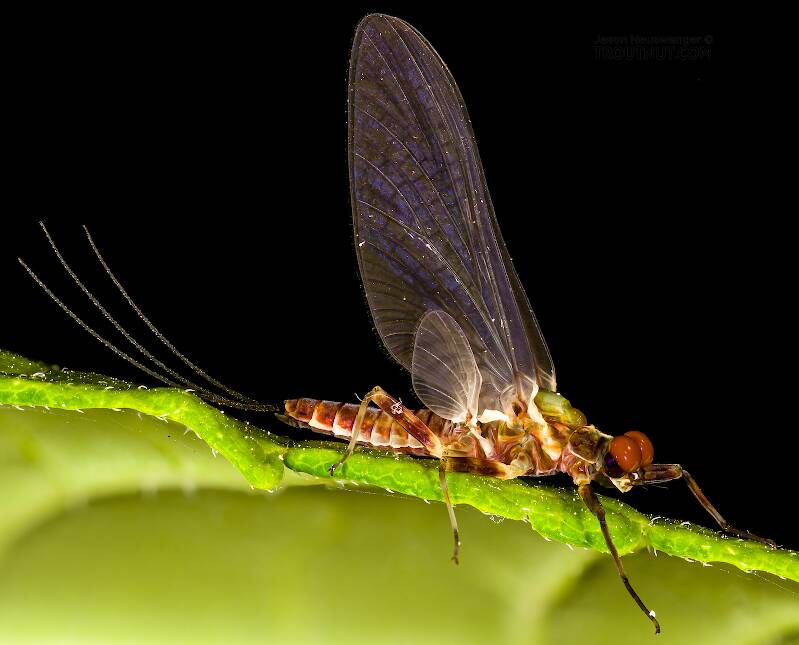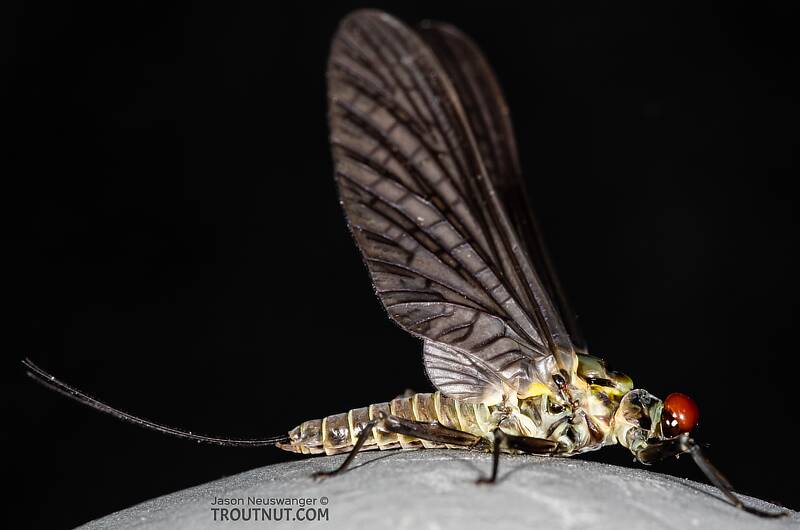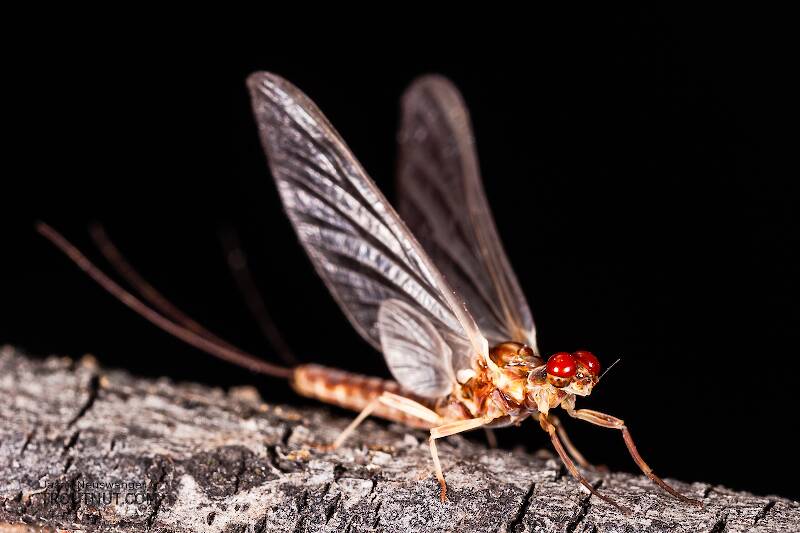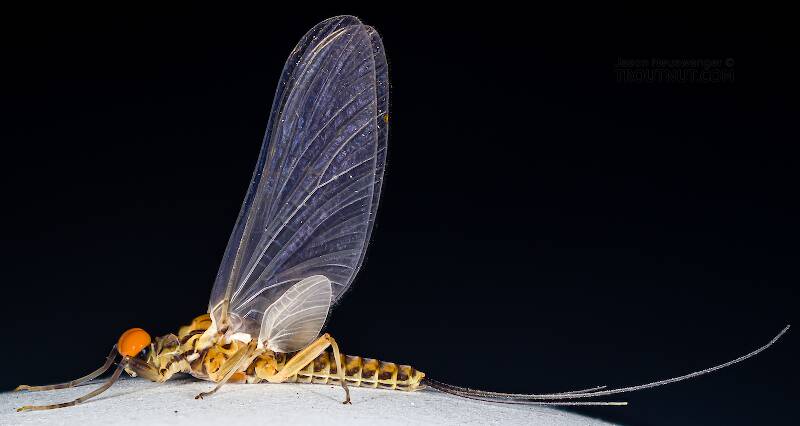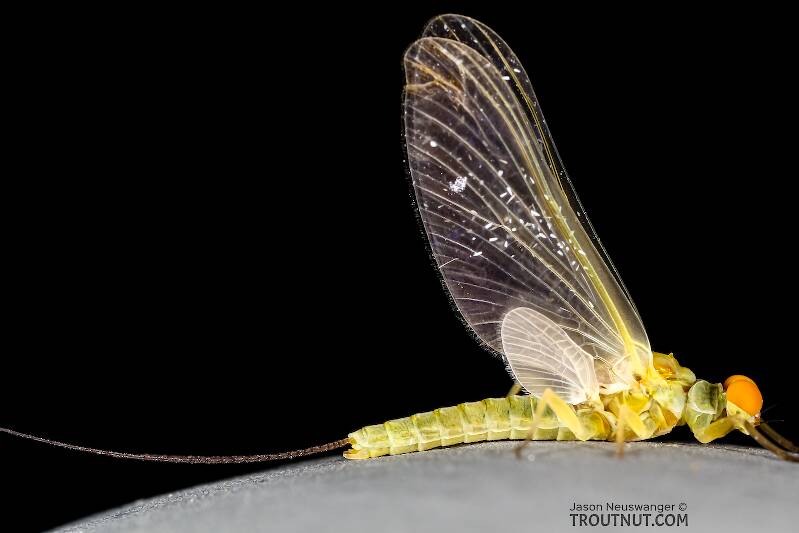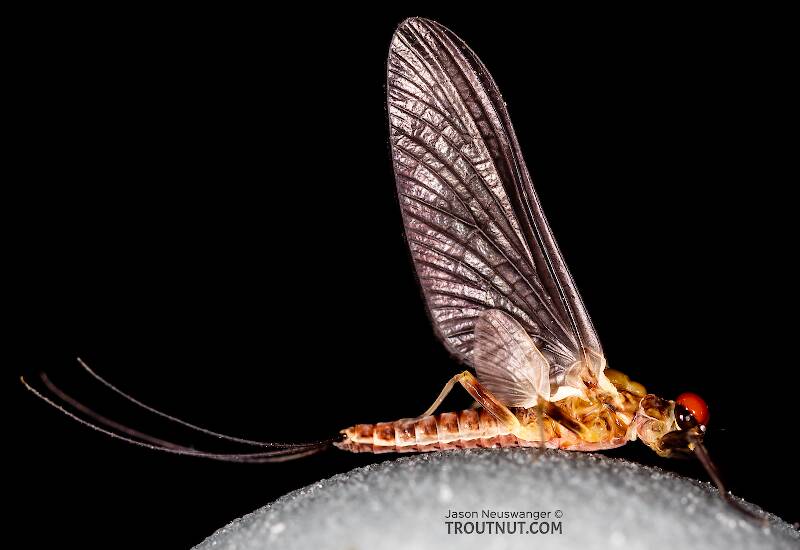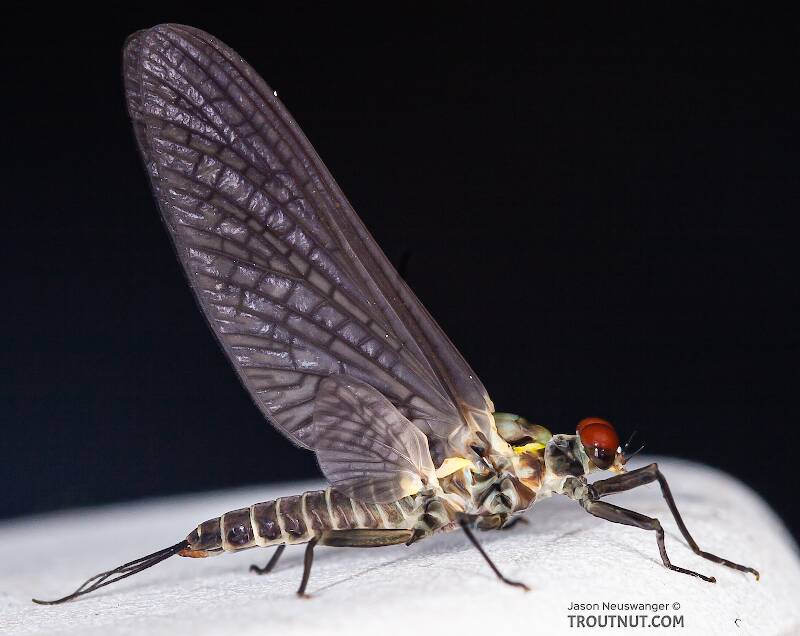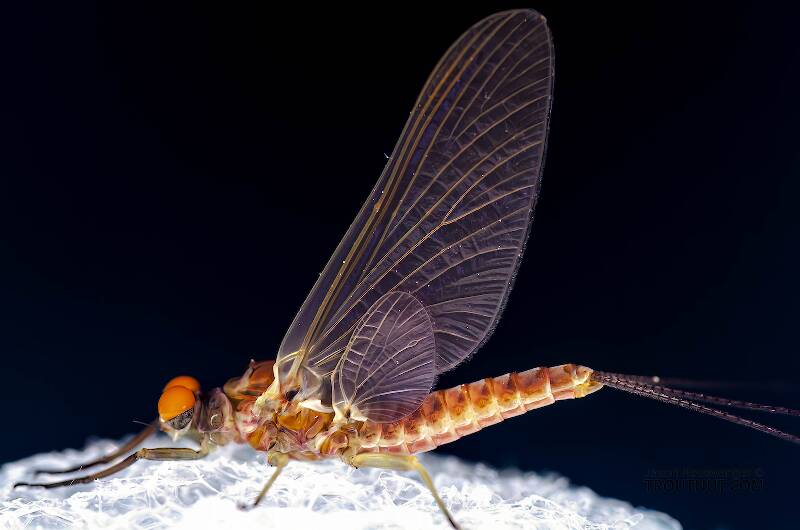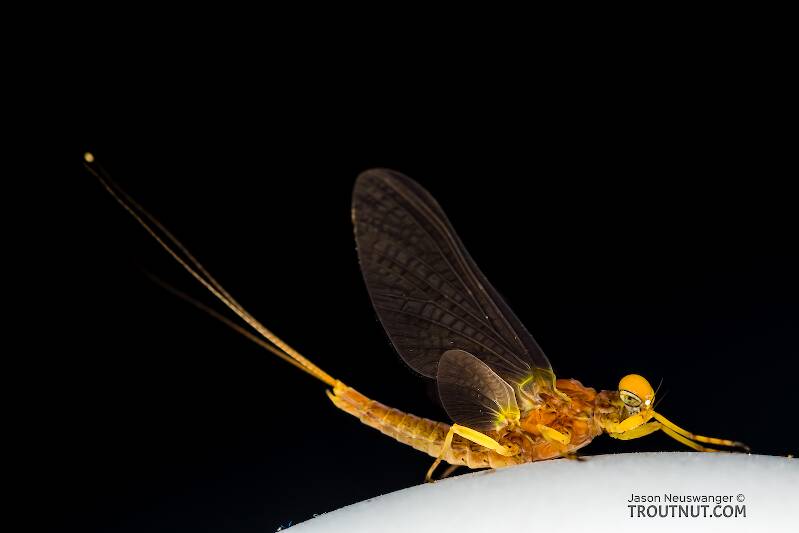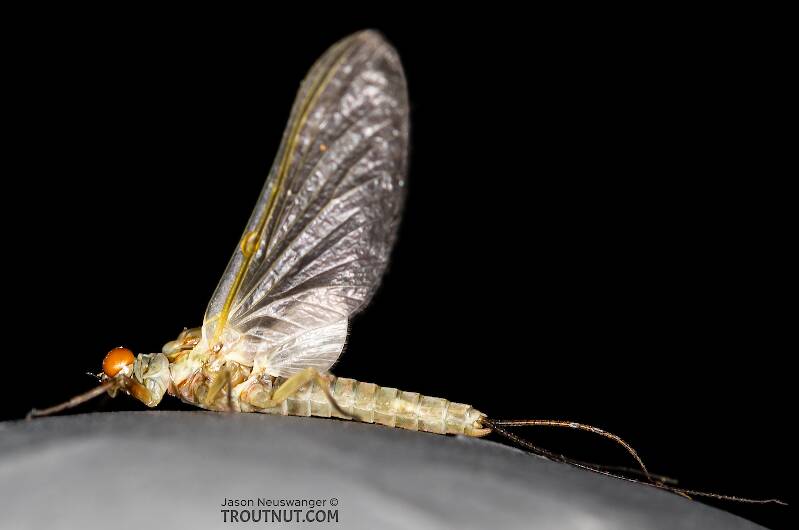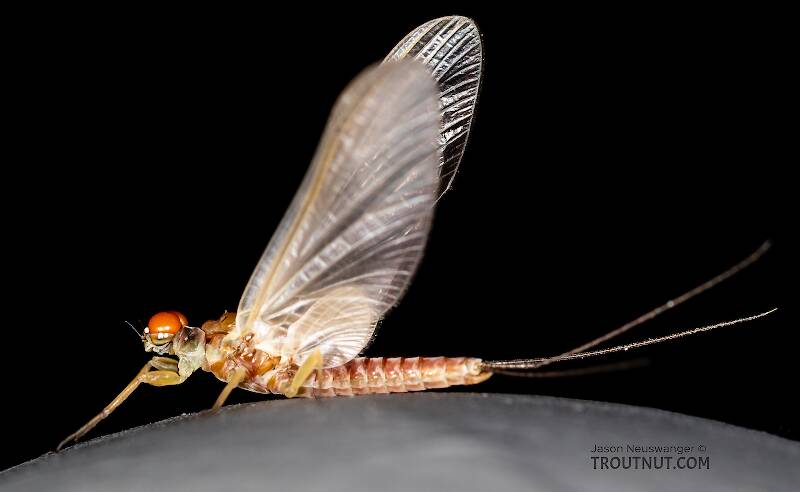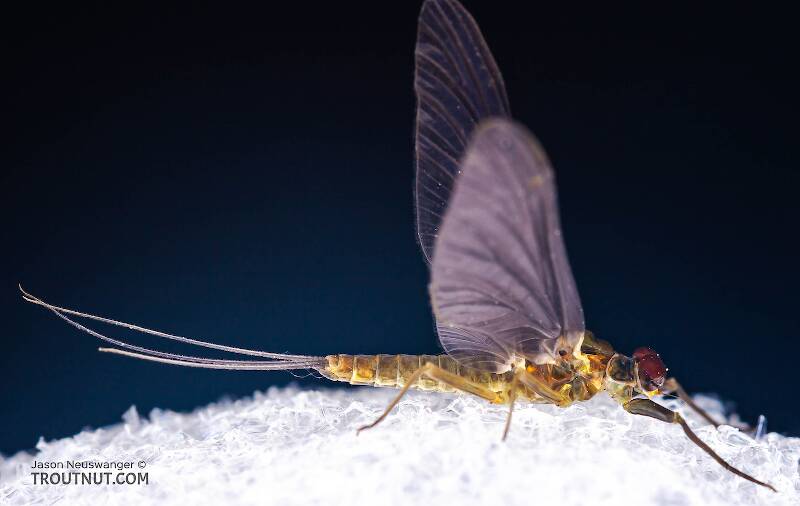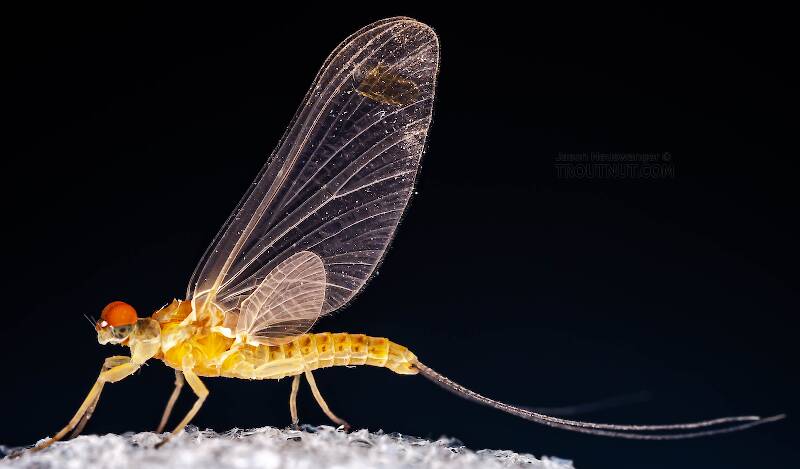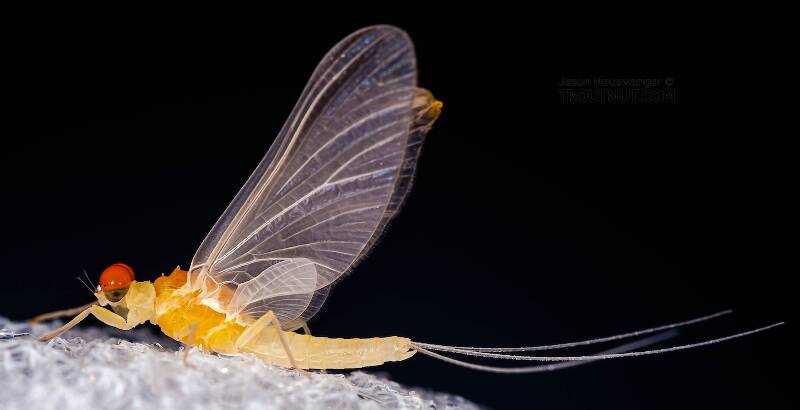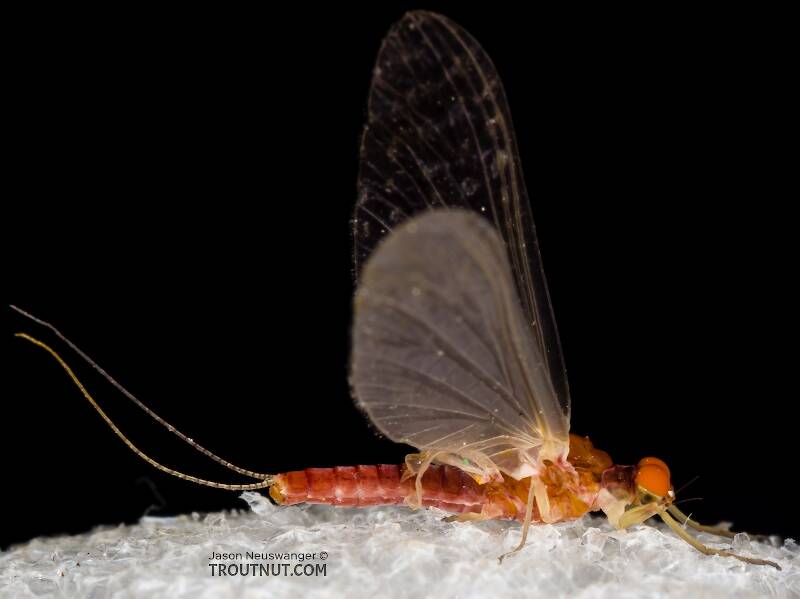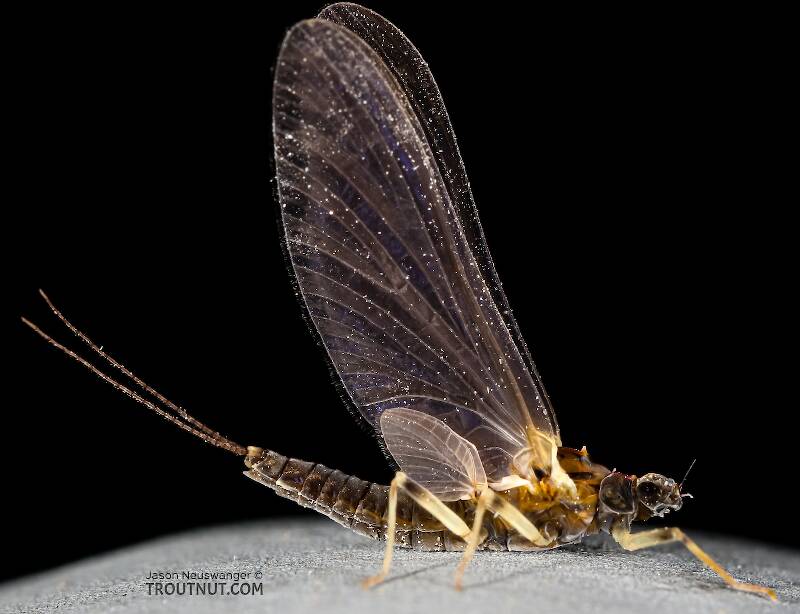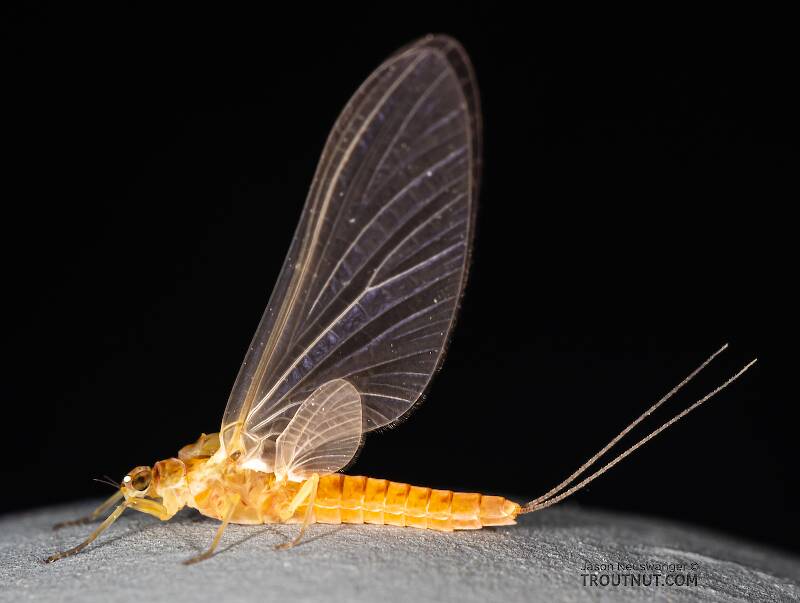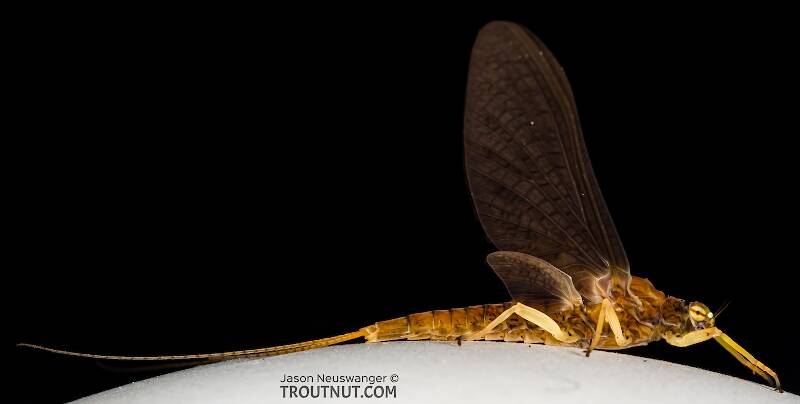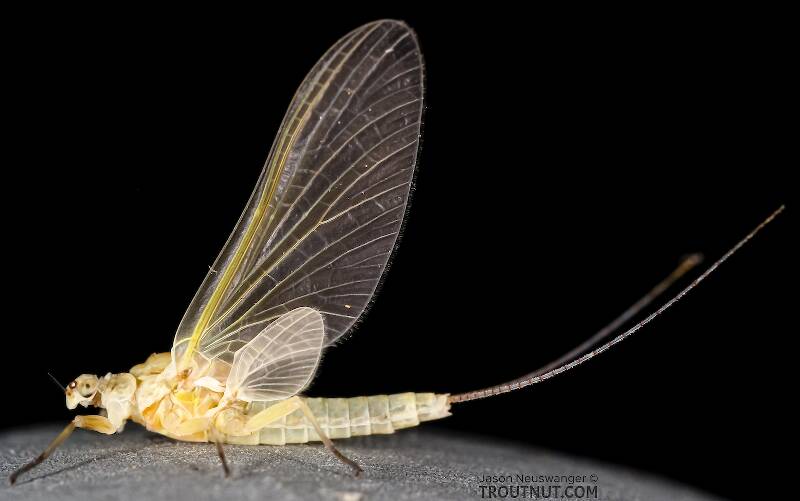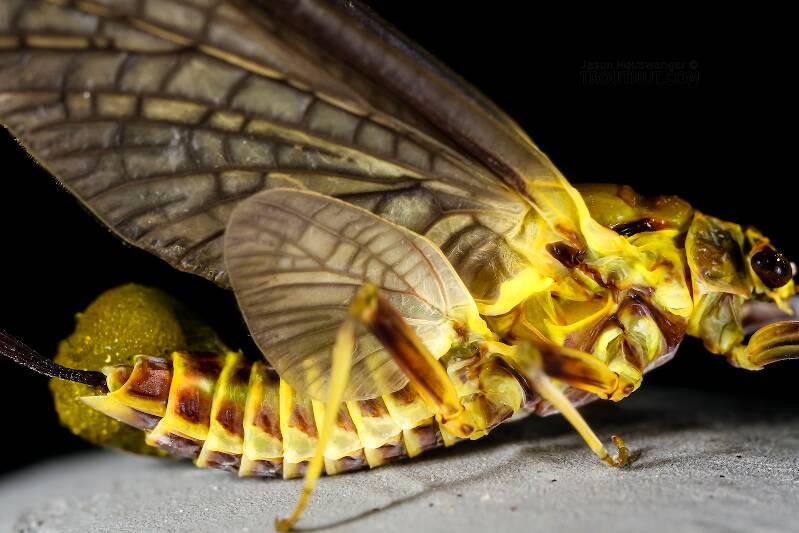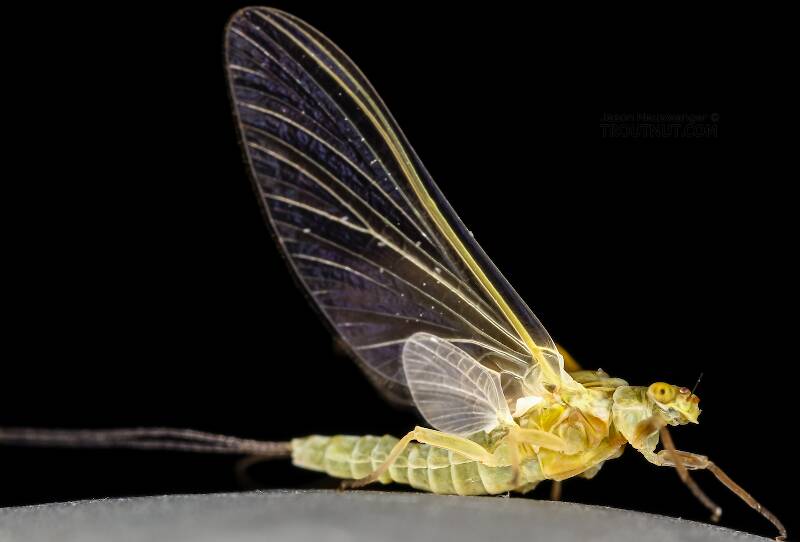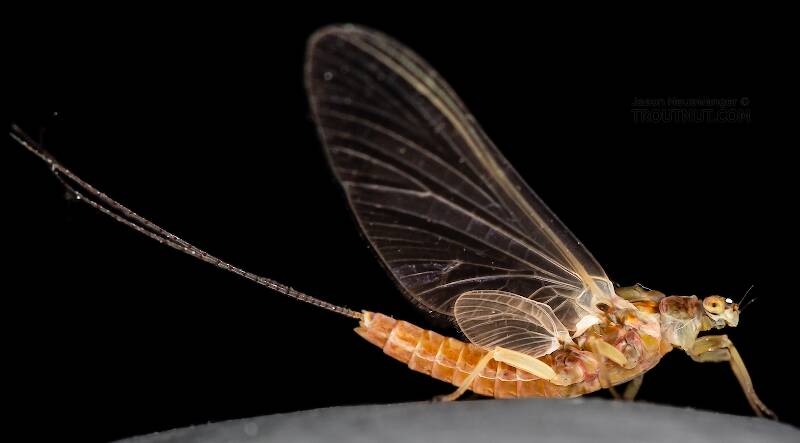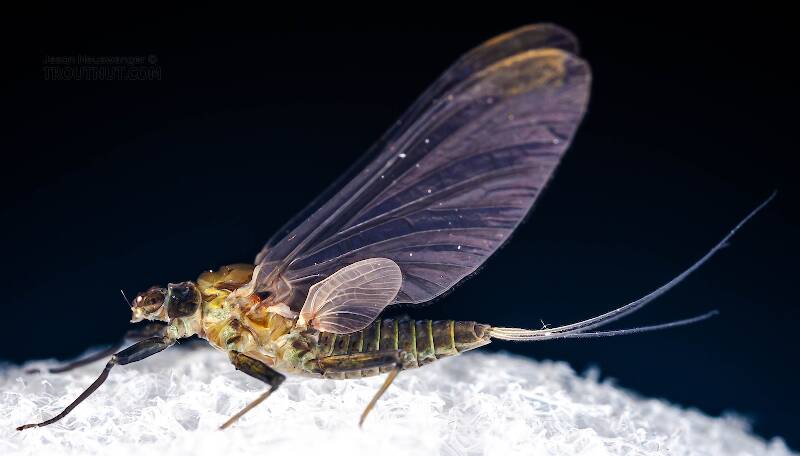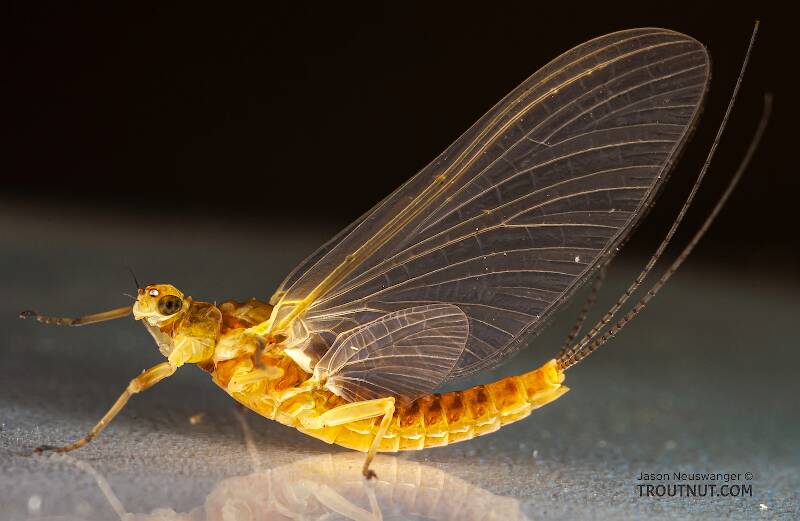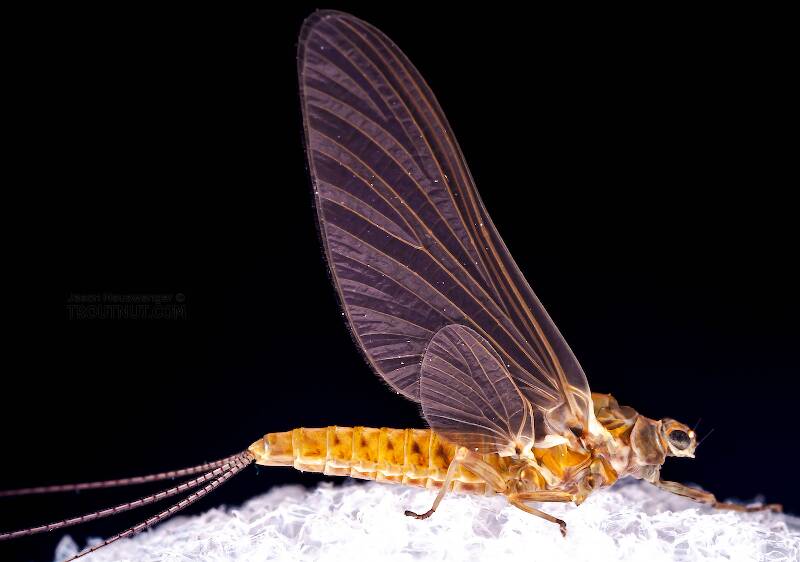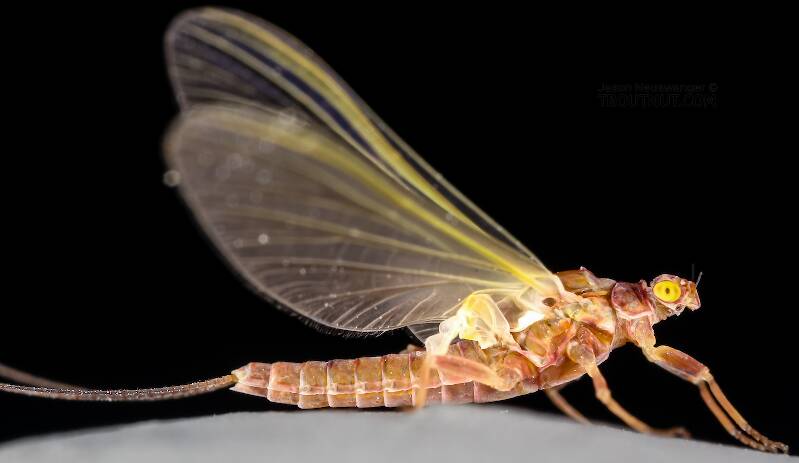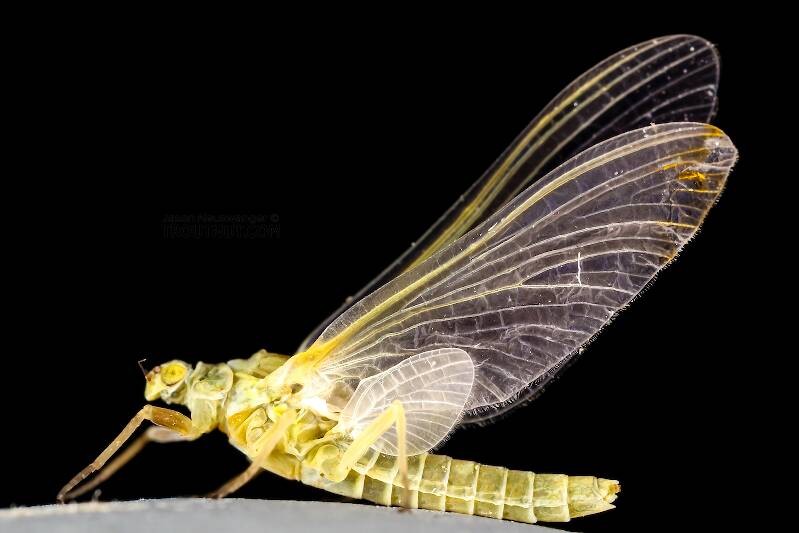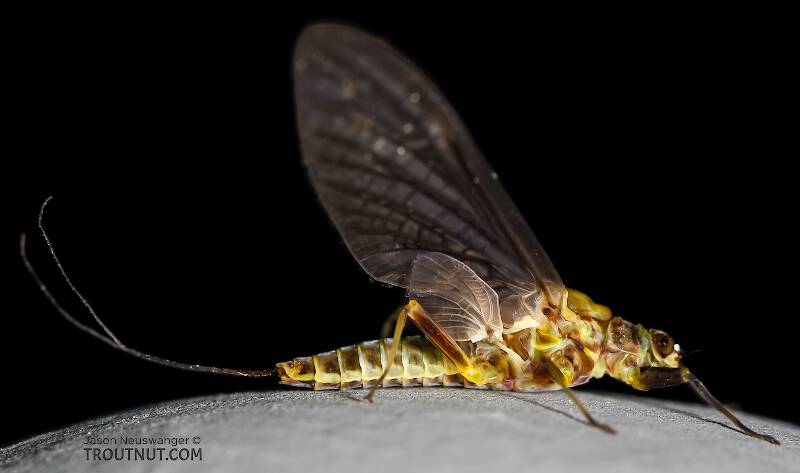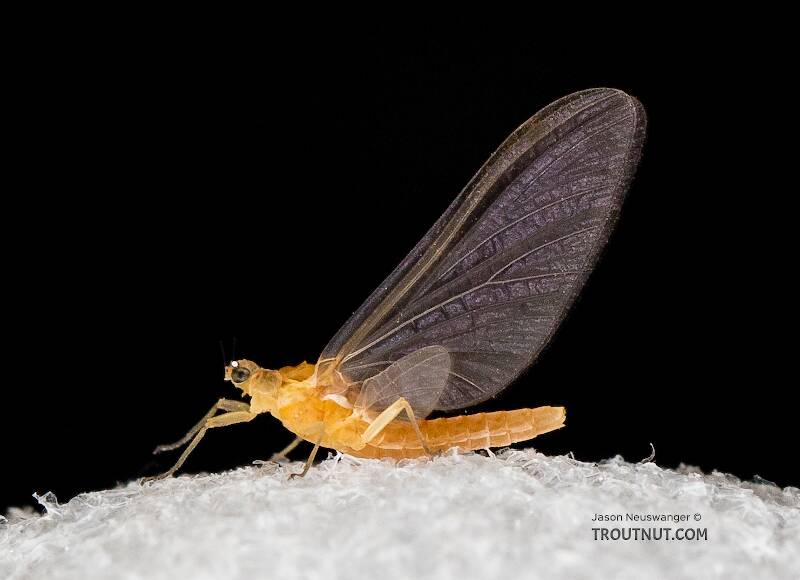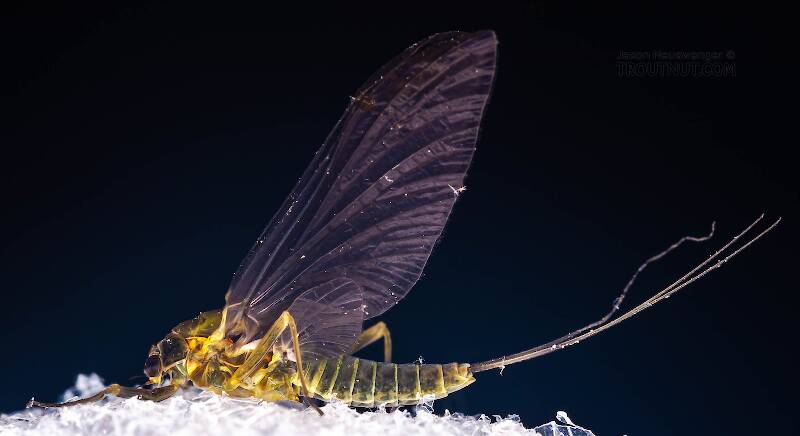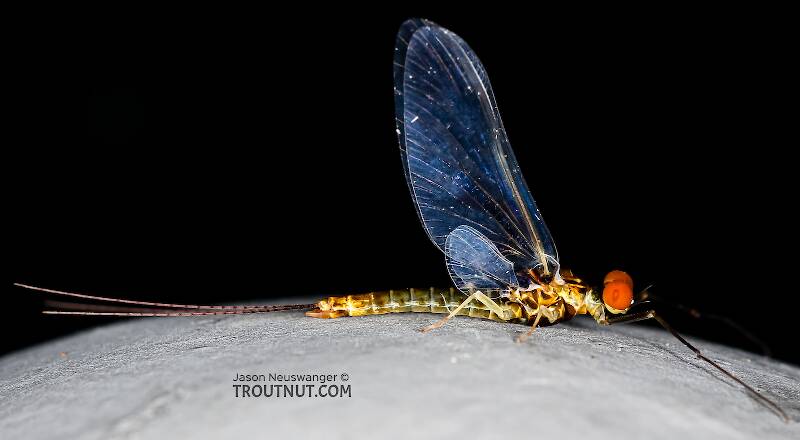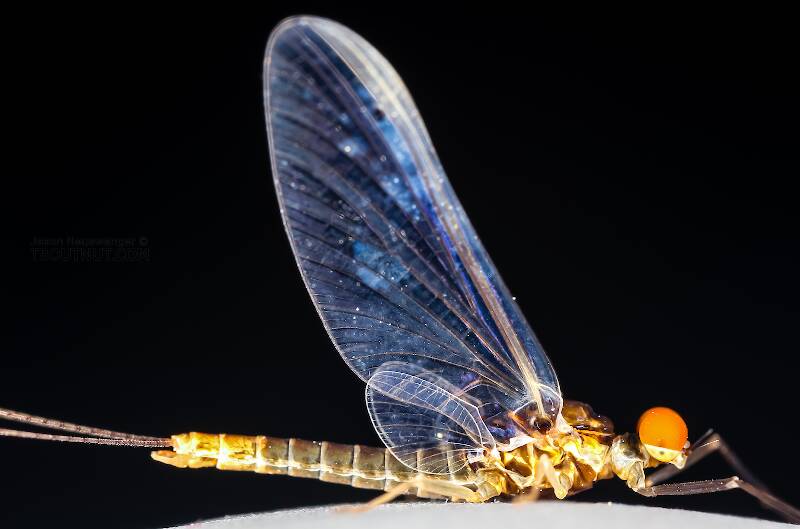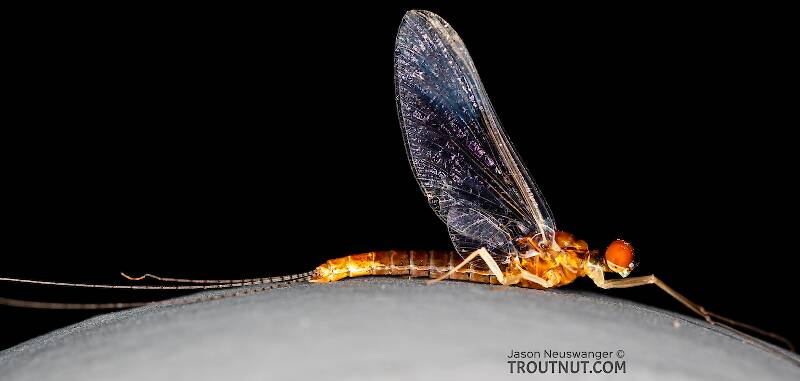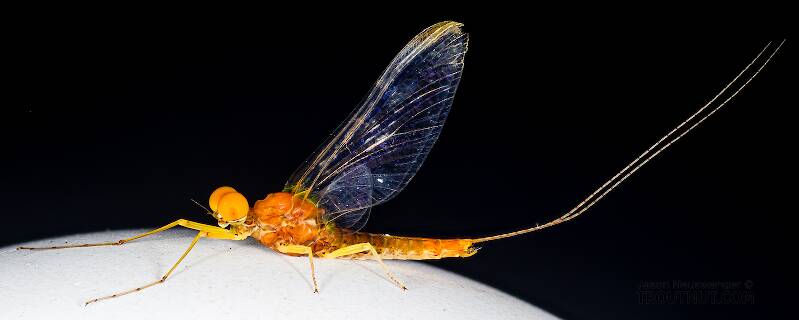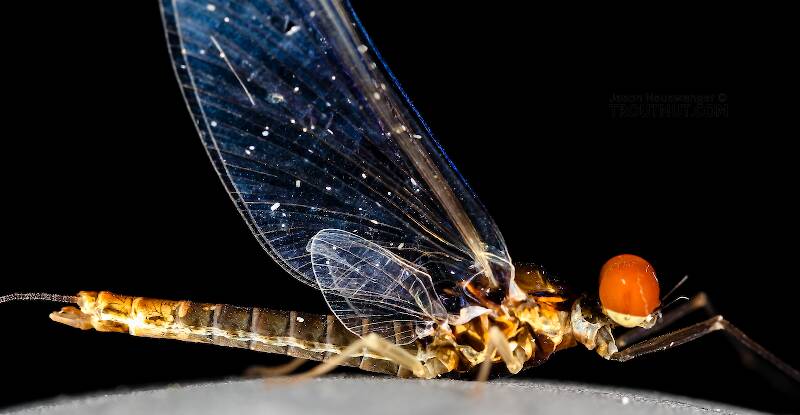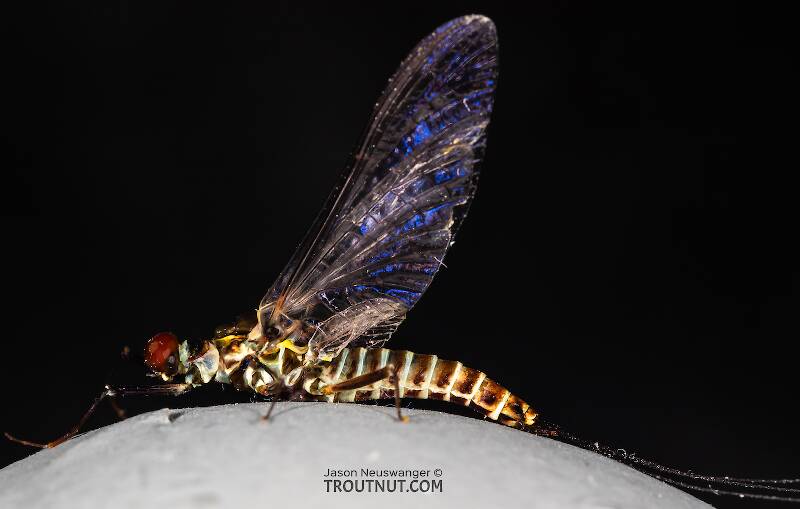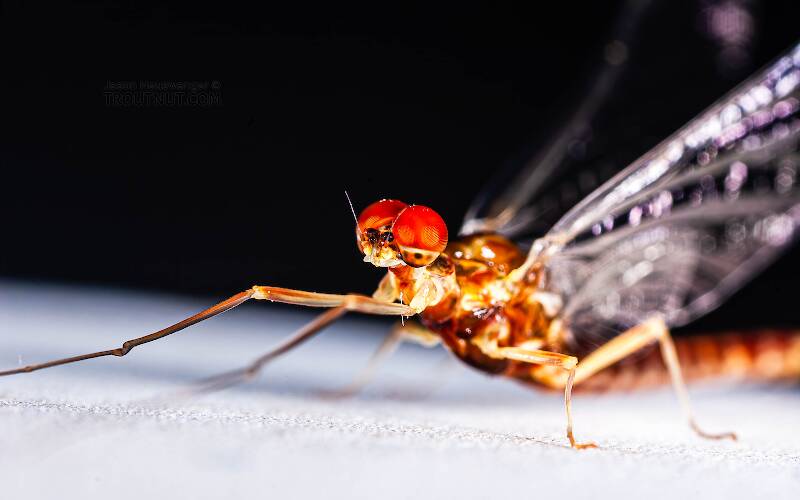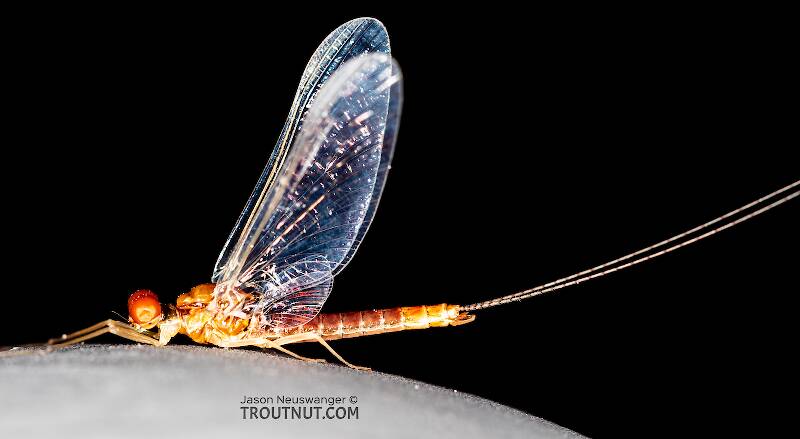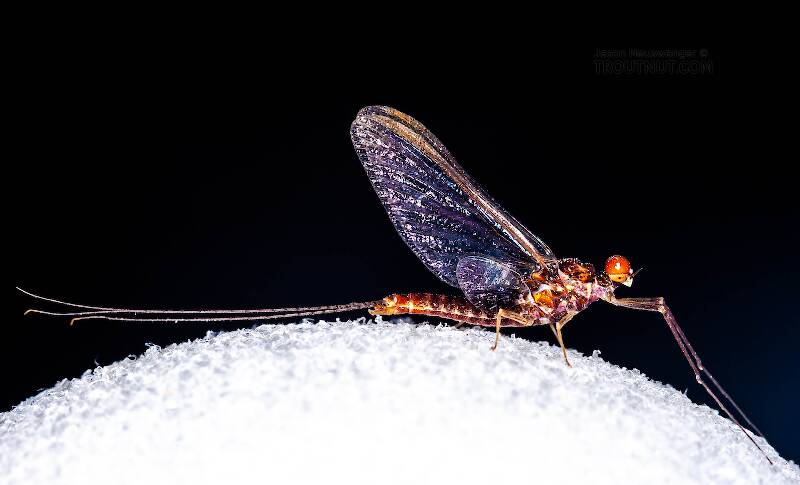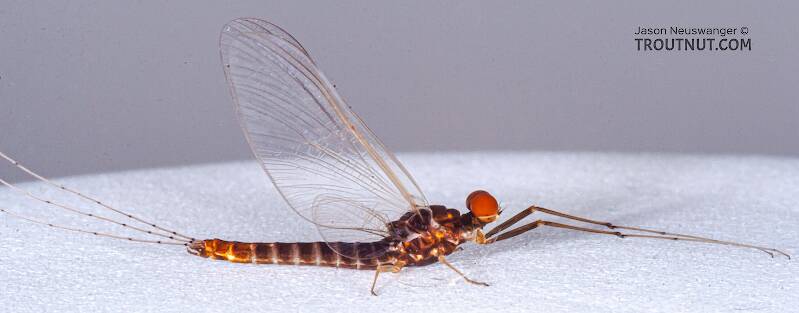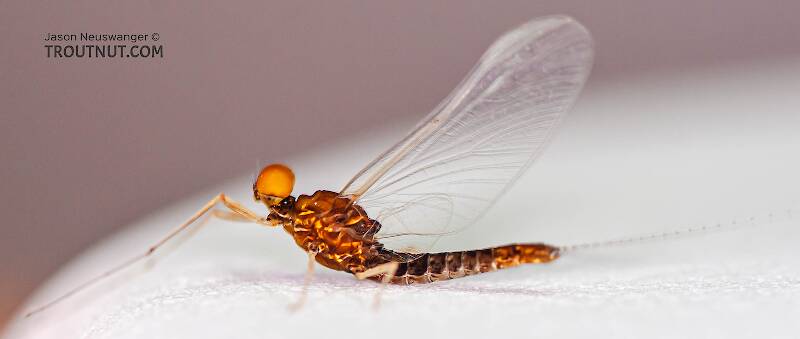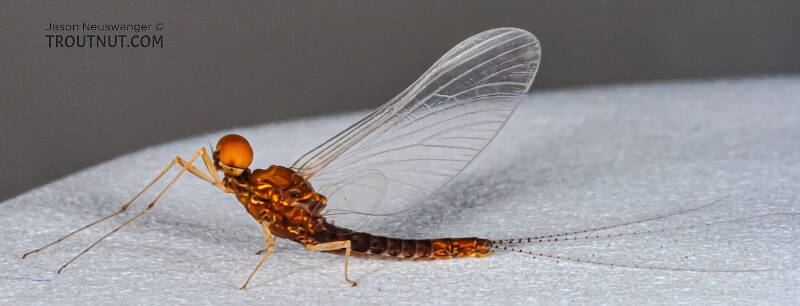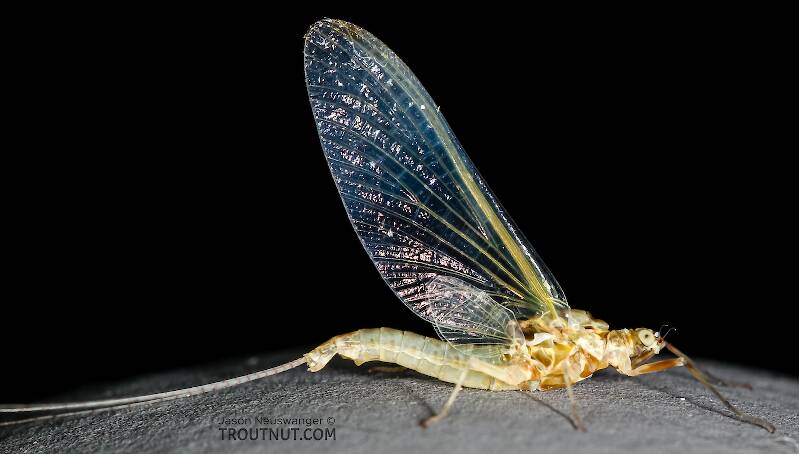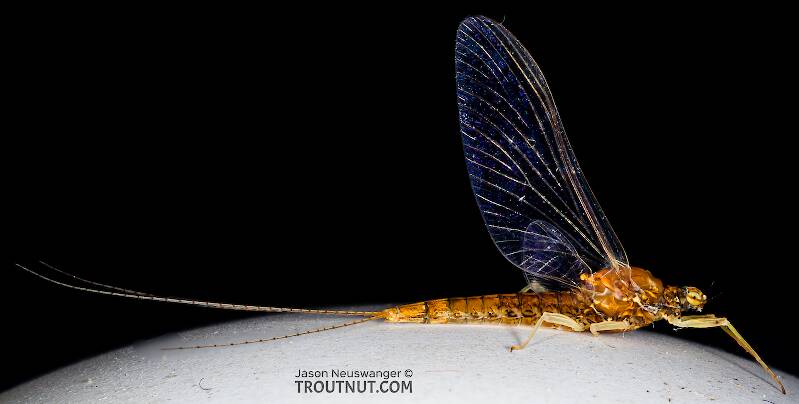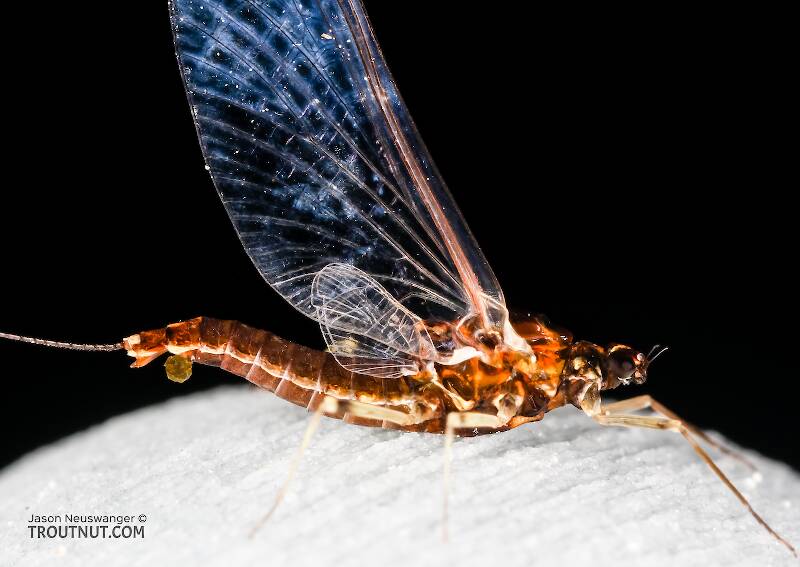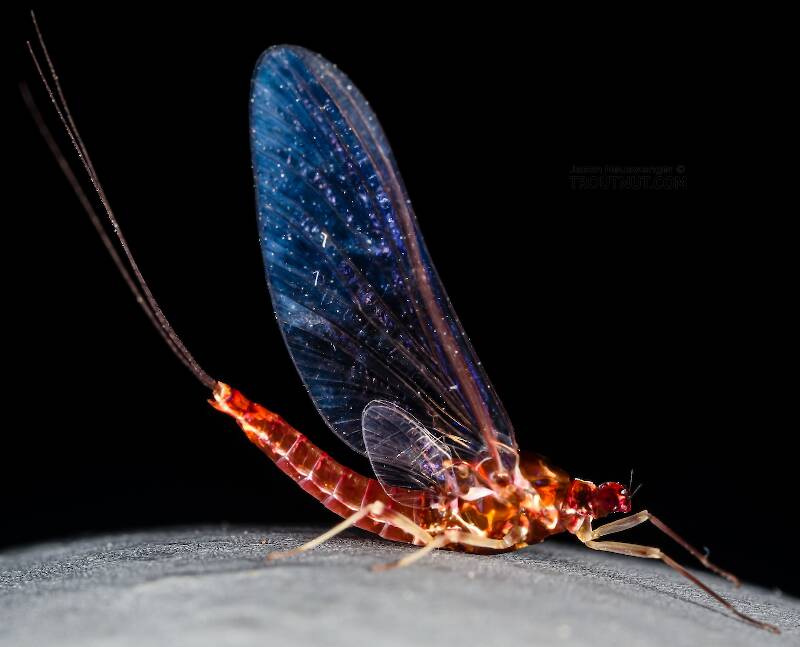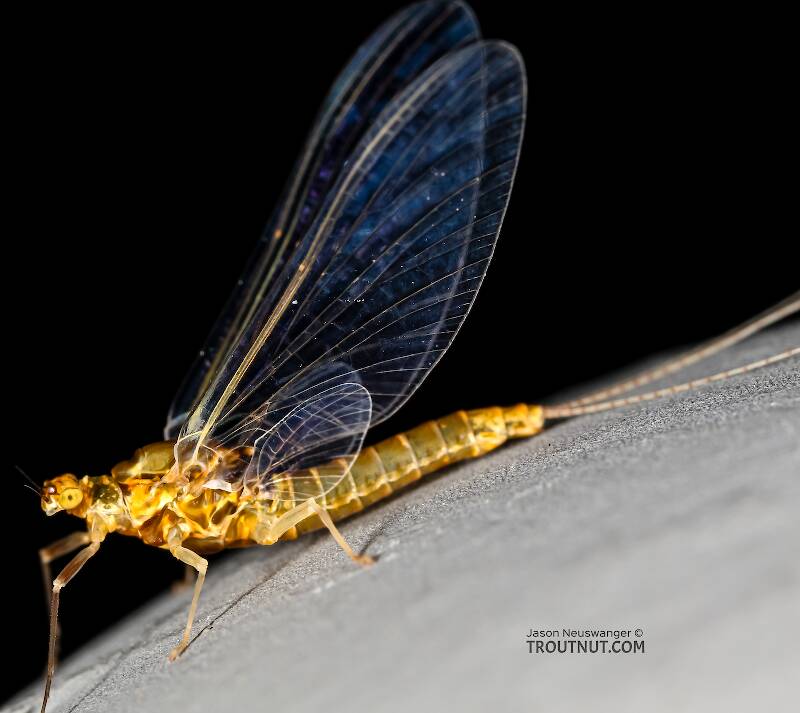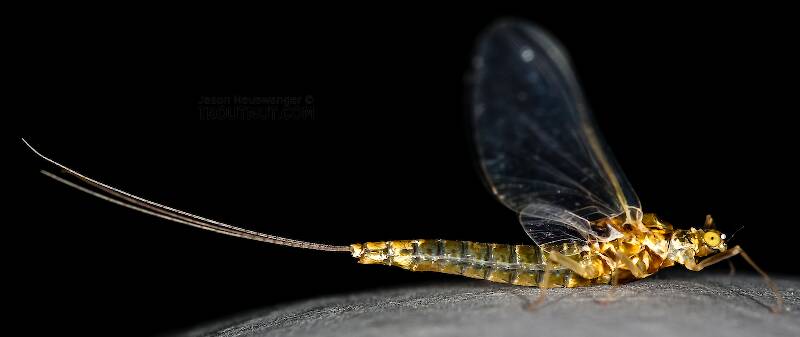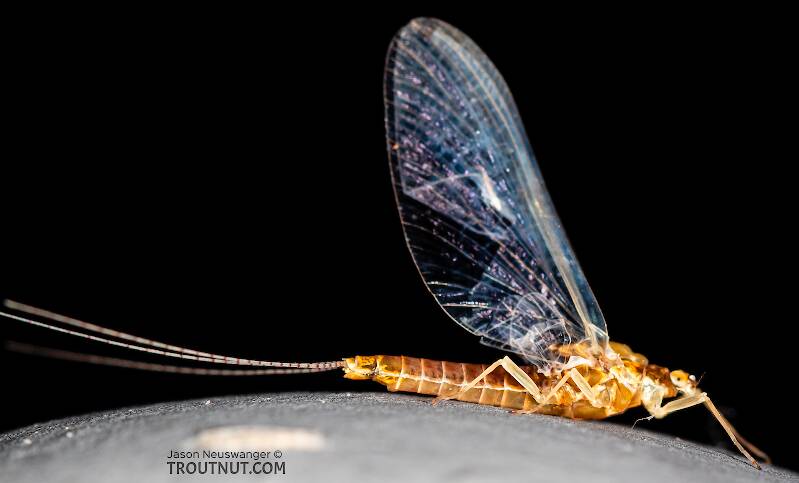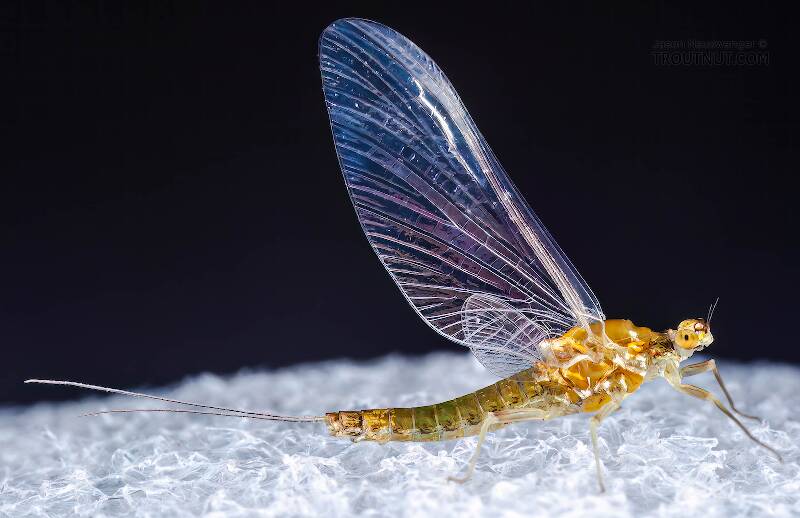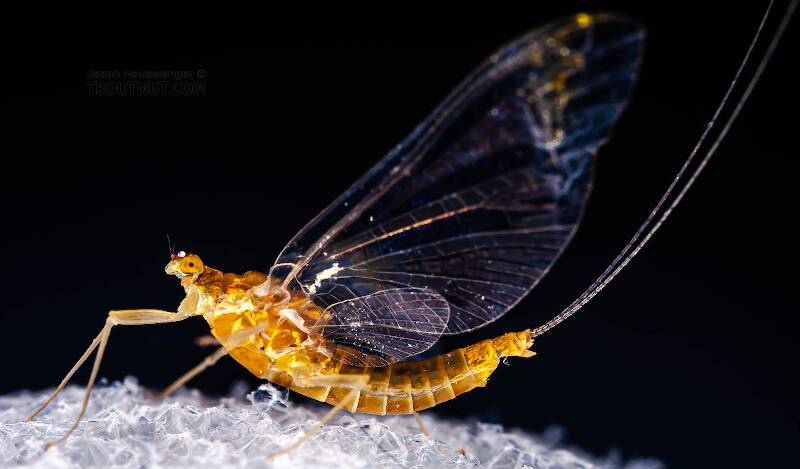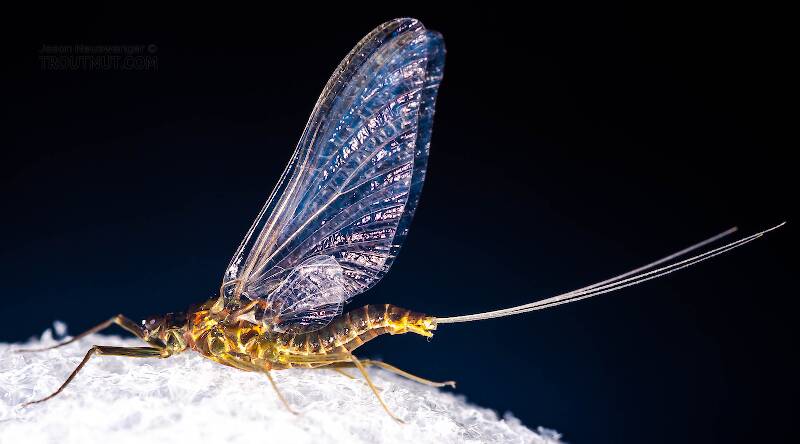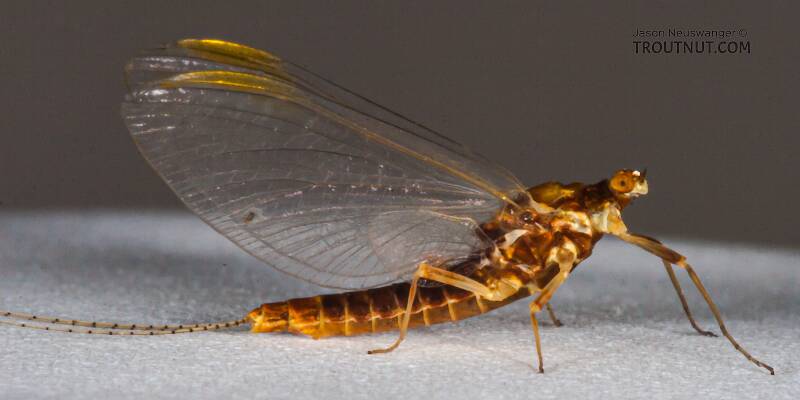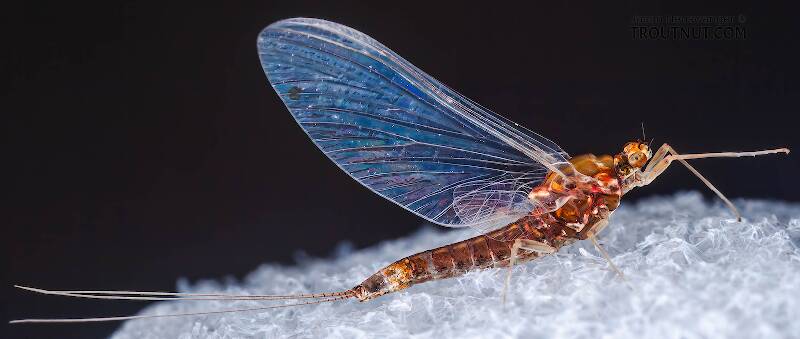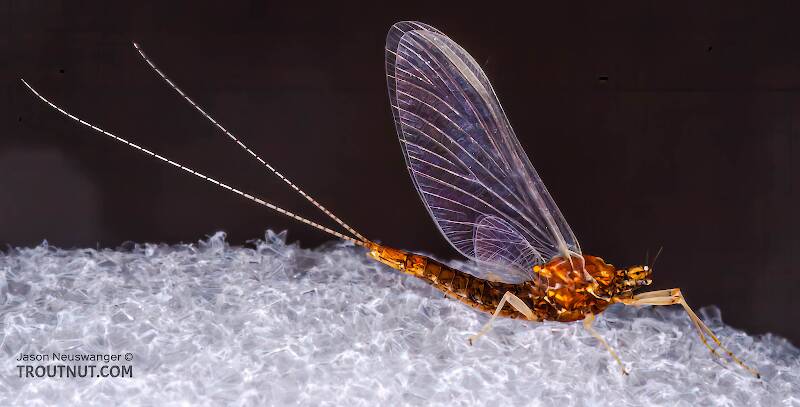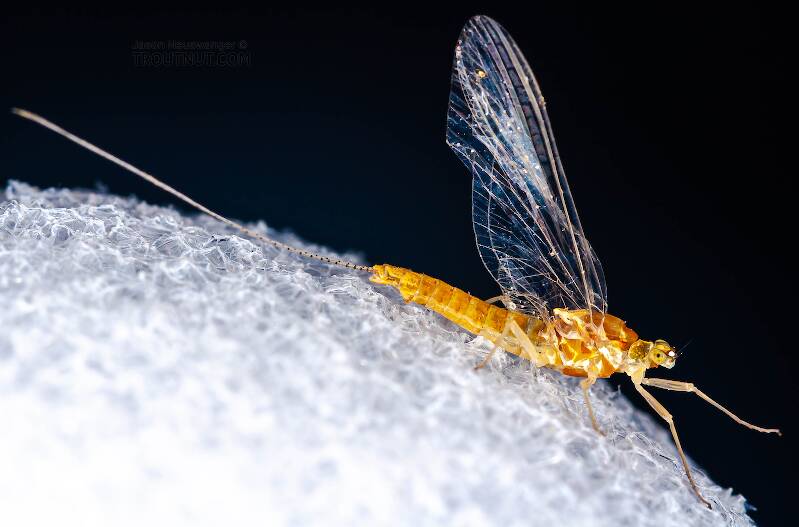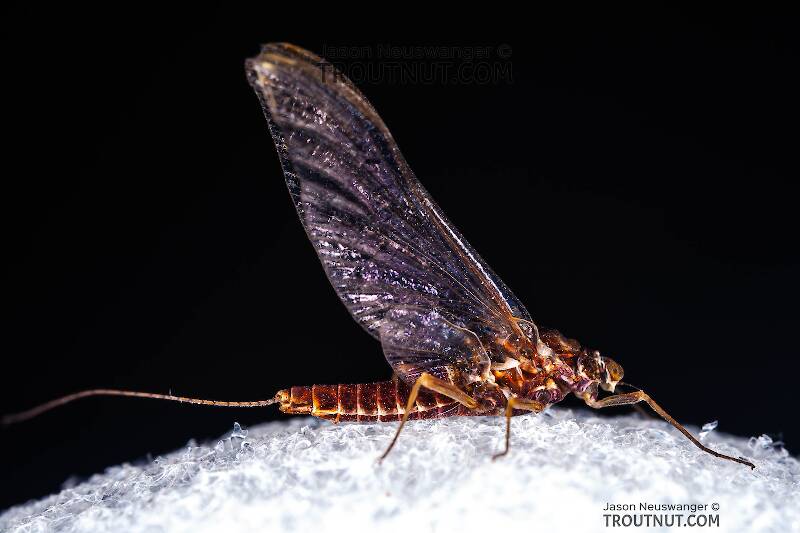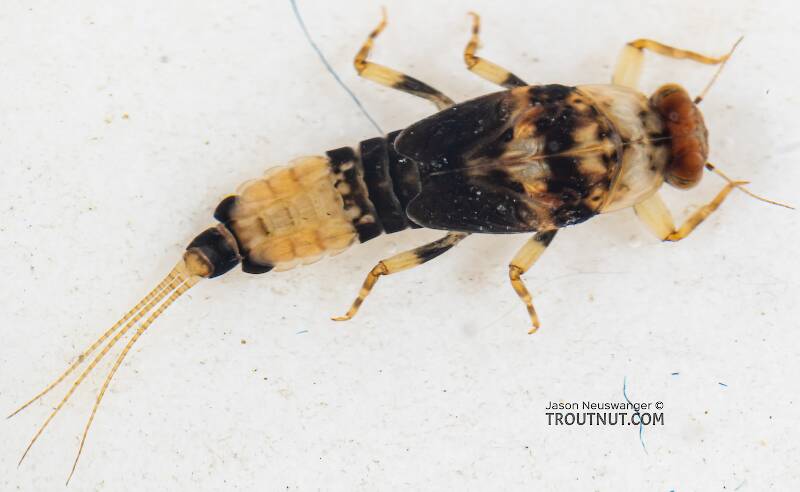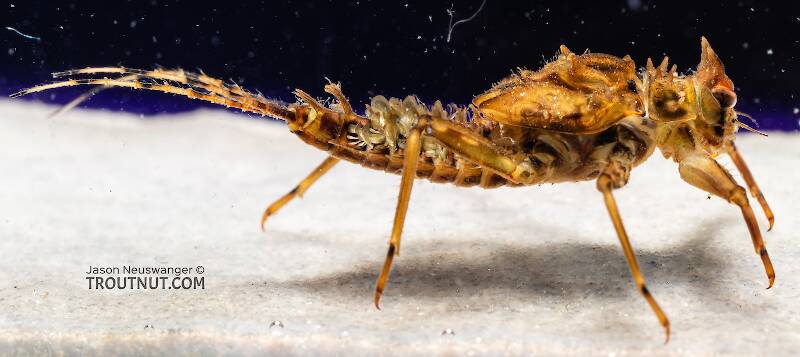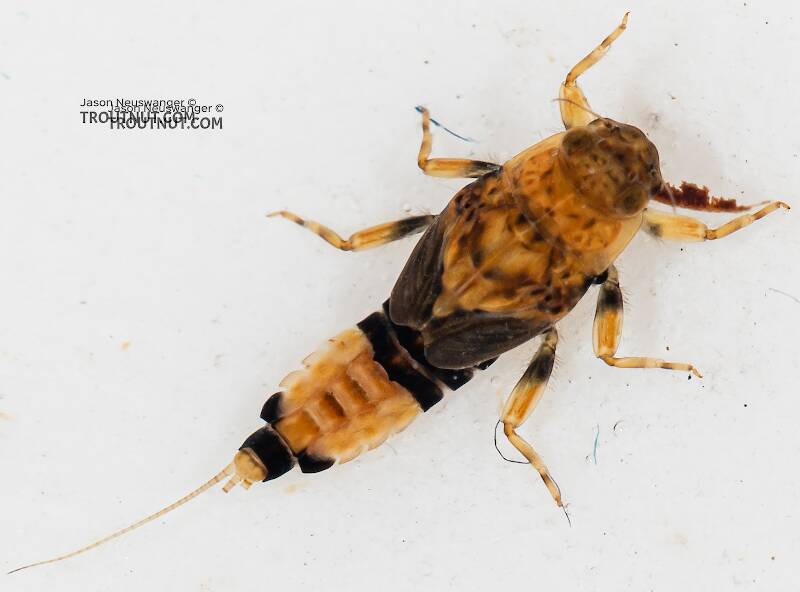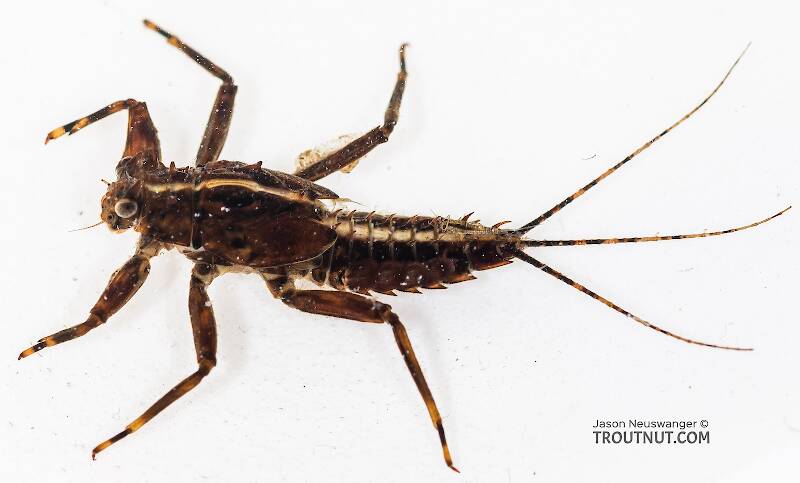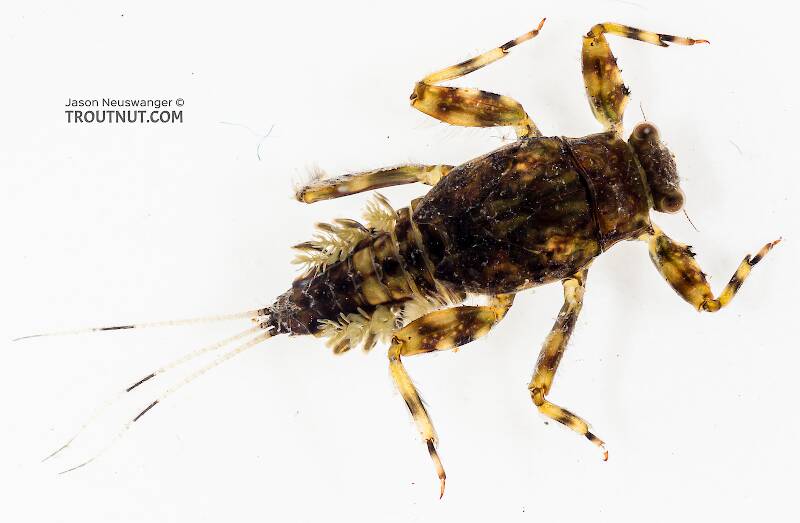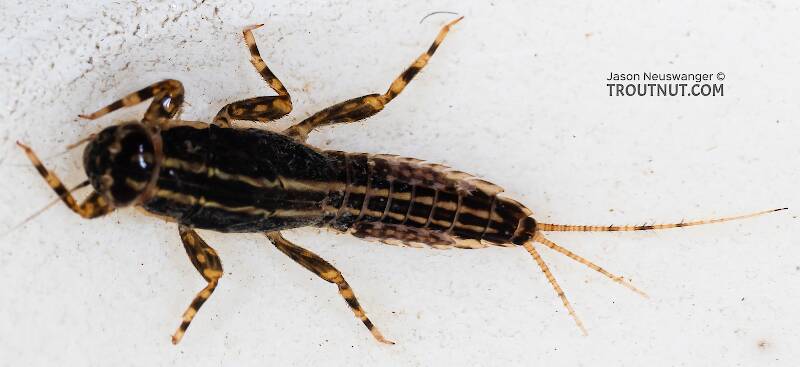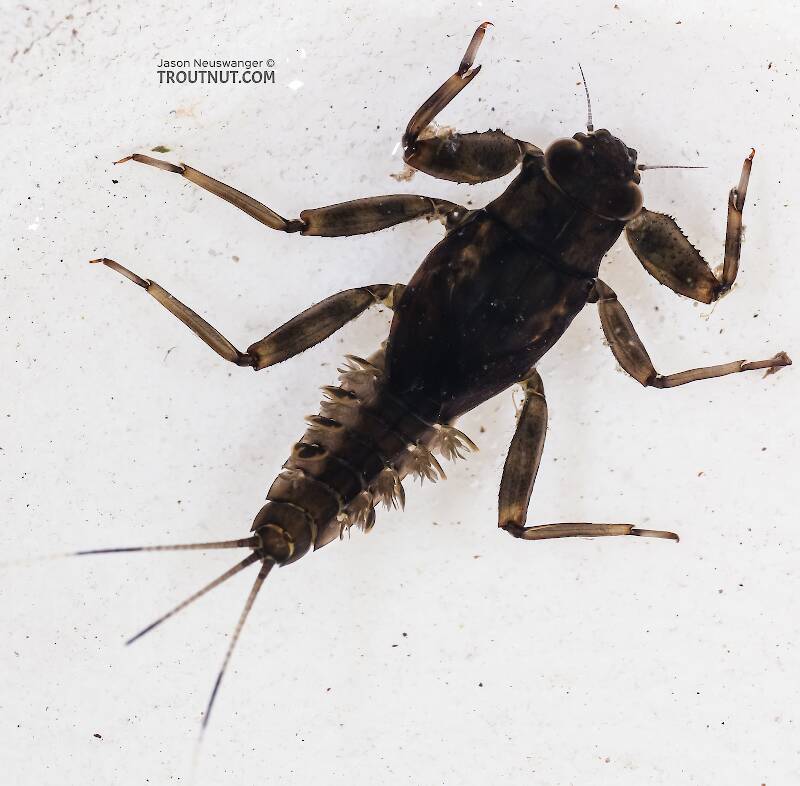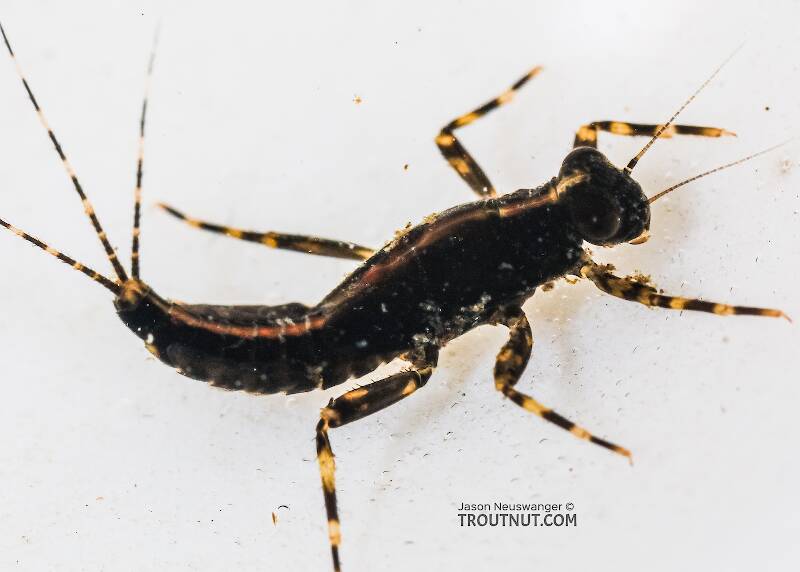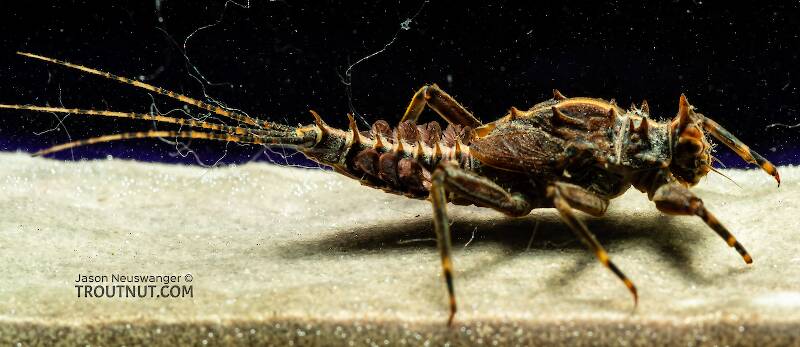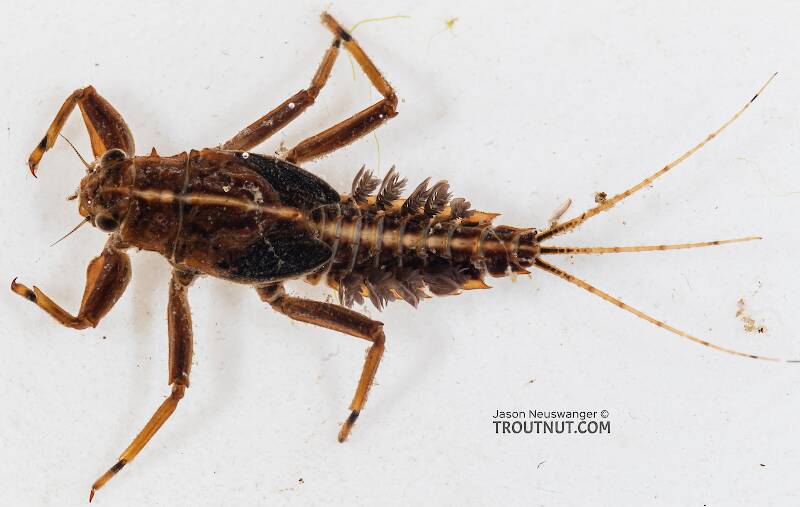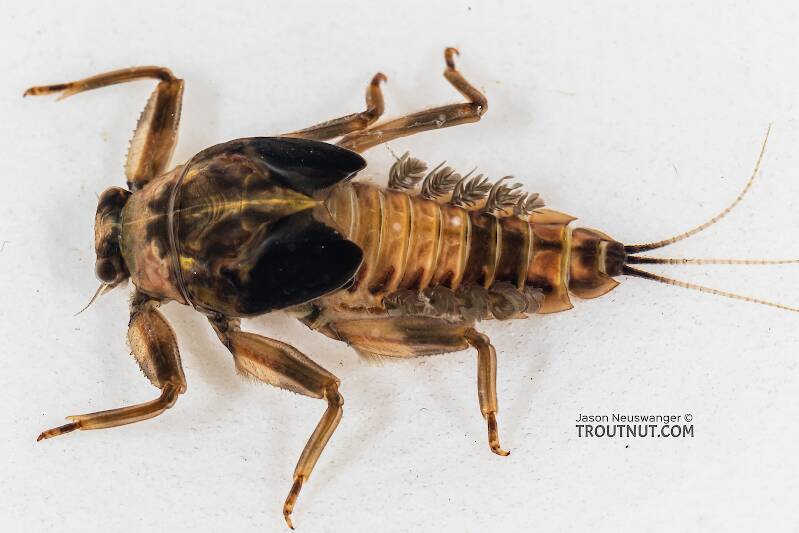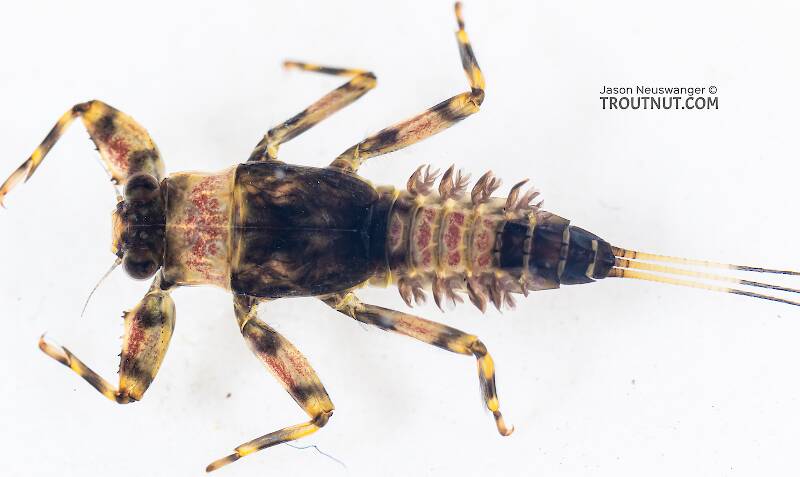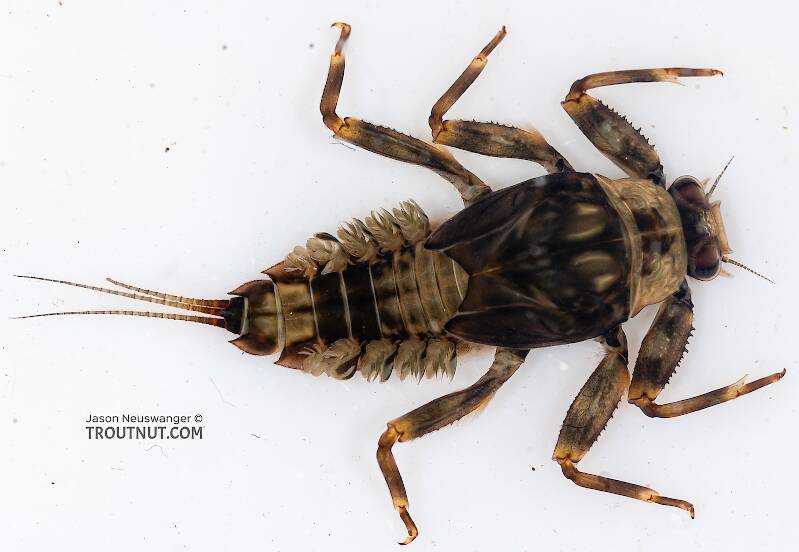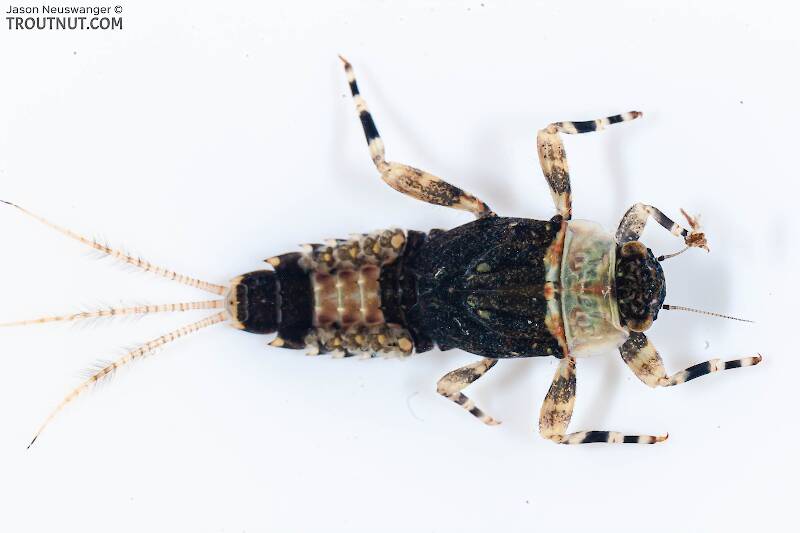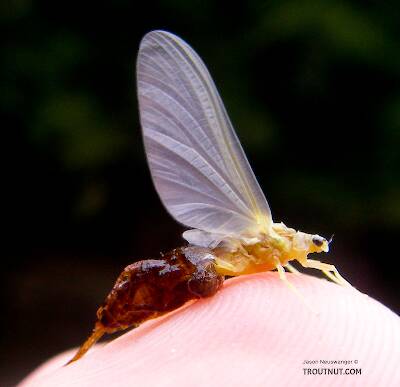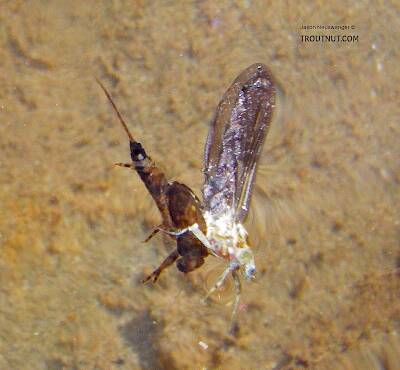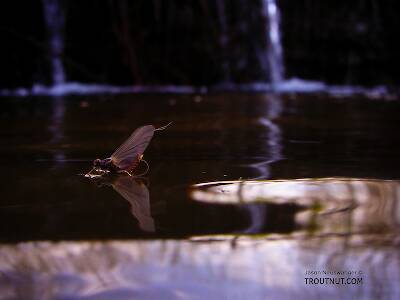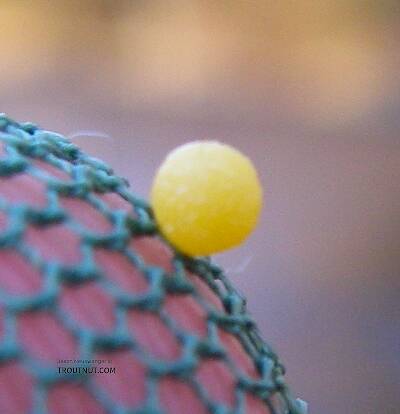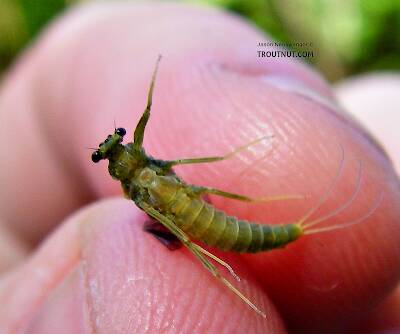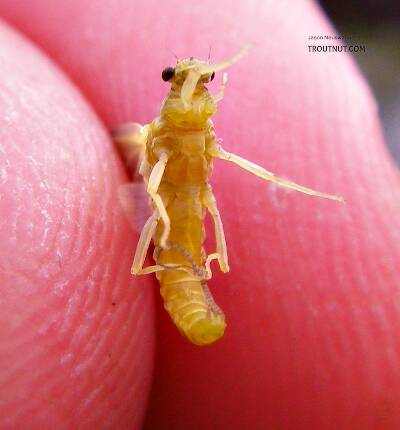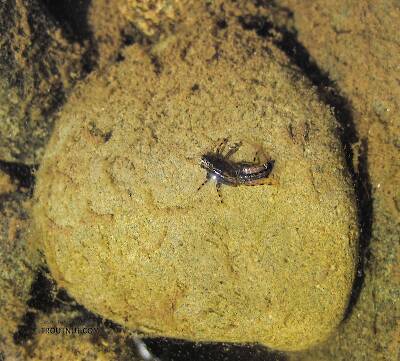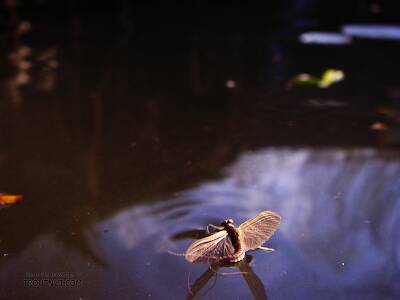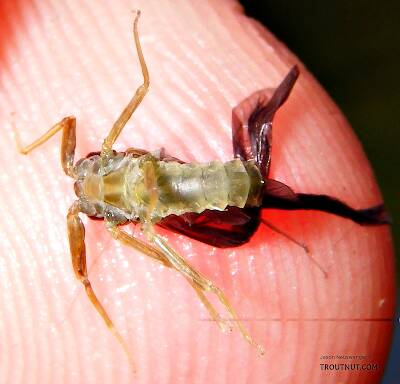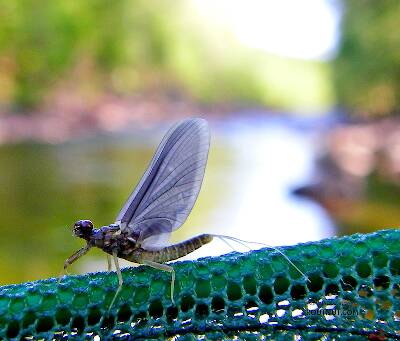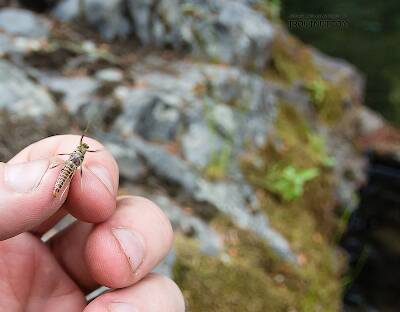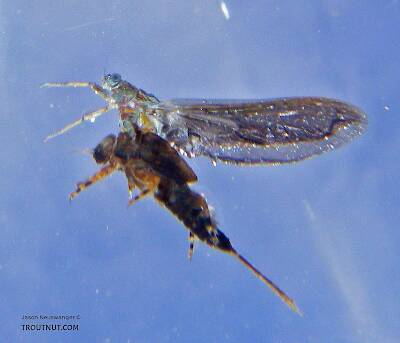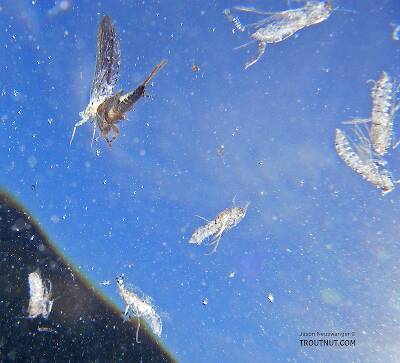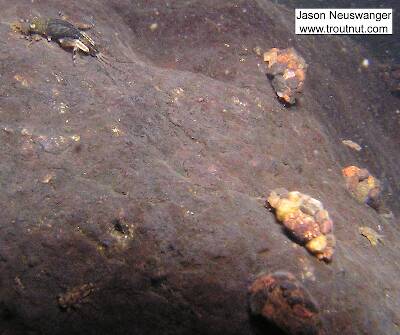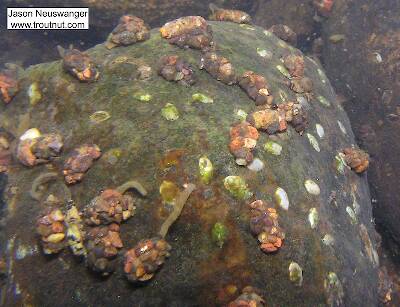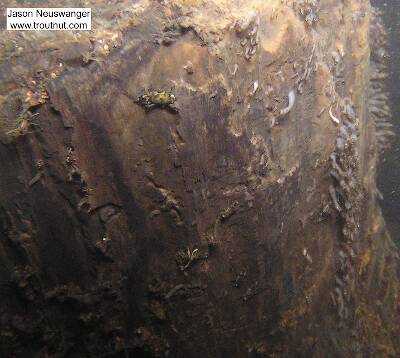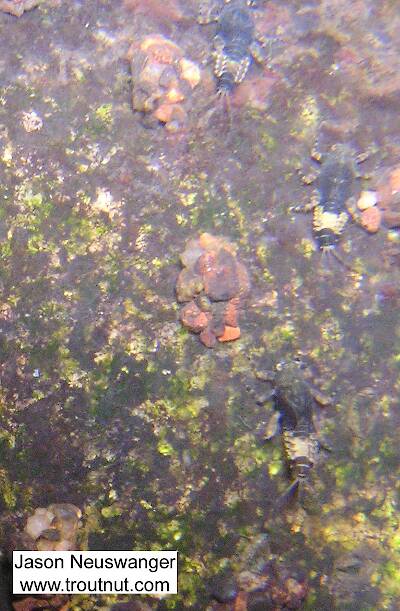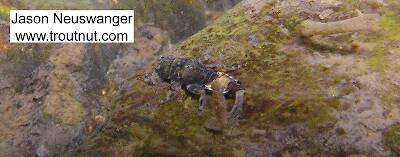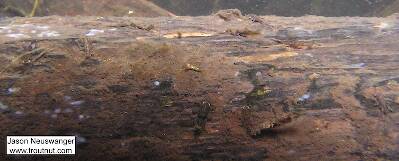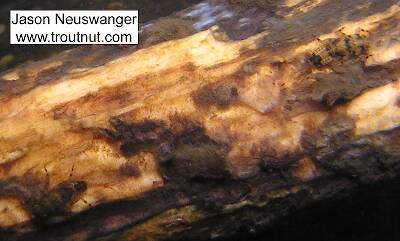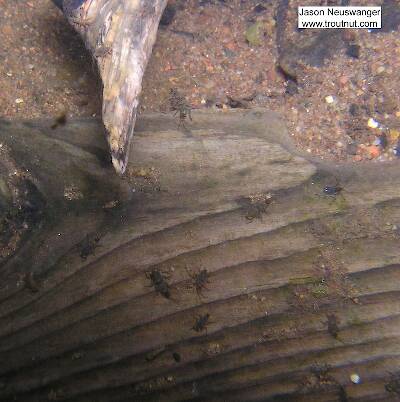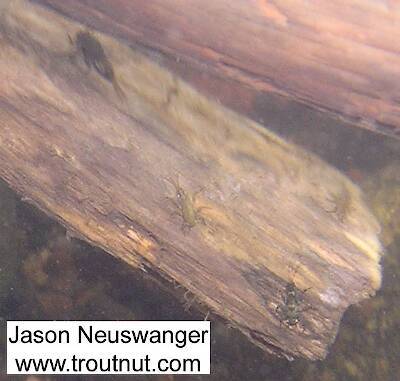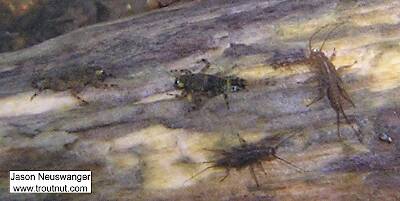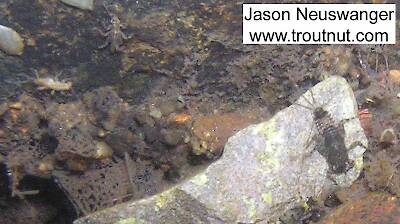
Hex Mayflies
Hexagenia limbata
The famous nocturnal Hex hatch of the Midwest (and a few other lucky locations) stirs to the surface mythically large brown trout that only touch streamers for the rest of the year.
Featured on the forum

This specimen keys to the Epeorus albertae group of species. Of the five species in that group, the two known in Washington state are Epeorus albertae and Epeorus dulciana. Of the two, albertae has been collected in vastly more locations in Washington than dulciana, suggesting it is far more common. On that basis alone I'm tentatively putting this nymph in albertae, with the large caveat that there's no real information to rule out dulciana.

Troutnut is a project started in 2003 by salmonid ecologist Jason "Troutnut" Neuswanger to help anglers and
fly tyers unabashedly embrace the entomological side of the sport. Learn more about Troutnut or
support the project for an enhanced experience here.
Mayfly Family Ephemerellidae (Hendricksons, Sulphurs, PMDs, BWOs)
The Ephemerellidae are undoubtedly the most important family of mayflies for the American trout angler. Most species known as Hendricksons, Pale Morning Duns and Sulphurs belong to the genus Ephemerella in this family, while the genus Drunella lays claim to many Eastern and Western Blue-Winged Olives and the Western Green Drakes.
Where & when
Ephemerellids can be found in virtually any cold water habitat across the continent. A curious fact about this family is that the males and females often inhabit different parts of the stream. In many species, the males and females are of different sizes and colors, and your fly may need to match the dominant gender emerging from your stretch of the river.In 532 records from GBIF, adults of this family have mostly been collected during June (36%), July (25%), May (17%), April (8%), and August (6%).
In 798 records from GBIF, this family has been collected at elevations ranging from 3 to 11601 ft, with an average (median) of 1444 ft.
Family Range
Hatching behavior
These are fantastic dry-fly insects. Behavior varies by species, but almost all have excellent qualities for the angler. Most eclode laboriously in the surface film, where emerger and floating nymph patterns are excellent. Others before reaching the surface, making them good wet-fly fare. Some species have been documented to engage in both forms thus opening debate over whether these two styles of emergence are driven by genetics or environmental influences. They can also take a very long time to prepare their wings for flight once they reach the surface. There they ride like miniature sailboats in the classic mayfly style, fluttering occasionally, and can be imitated by a plethora of upright winged dry fly patterns.Many species are especially prone to being stillborn or crippled, and trout are especially fond of this wounded prey and can be fooled by our crafty imitations.
Spinner behavior
Most species return to the stream as spinners one day after they emerge. Spinner falls are usually concentrated over the riffles, but occur over selected stretches on waters lacking this feature.Nymph biology
Nymphs of this family are a gift to the angler, because many have the peculiar habit of swimming up and down between the surface and the bottom several times before actually emerging. The actual biological purpose these seeming "practice runs" serve is open to debate, but they expose the slow-swimming nymphs to the trout. This behavior has been described by biologists as pulses of benthic drift, and they can do so in astounding numbers. They do the same near the surface as well.Several authors write that some of the nymphs crawl to the high tips of rocks and other objects prior to emergence, where they may be picked off their perches by peckish trout. During the spring months, they can often be found grazing in such exposed locations even when they aren't about to emerge.
Between their tendency to be in exposed places and behavioral drift, the nymphs of this family are important to trout year-round. Their imitations often prove successful anywhere in the water column.
Identification
To determine whether a specimen of Ephemeroptera belongs to Ephemerellidae, use the Key to Families of Mayfly Nymphs or Key to Families of Mayfly Duns and Spinners.
Specimens of the Mayfly Family Ephemerellidae
15 Male Duns
15 Female Duns
13 Male Spinners
15 Female Spinners
15 Nymphs
11 Streamside Pictures of Ephemerellidae Mayflies:
18 Underwater Pictures of Ephemerellidae Mayflies:
Discussions of Ephemerellidae
PMD Spinner - Egg sack color?
20 replies
Posted by Wbranch on Jan 26, 2010 in the species Ephemerella excrucians
Last reply on Aug 18, 2020 by Troutnut
Do any of you entomologist types know the true color of the PMD spinner? Dorothea or excrucians. Where I fish in MT there are huge spinner falls, many spents are on the water in the morning and others fall again at various periods during the day. I'd like to tie some with egg sacks as I saw many in July but forgot what color they were. Thanks.
rotunda
8 replies
Posted by CharlieBugs on Jan 25, 2015 in the species Ephemerella invaria
Last reply on Feb 1, 2015 by Gutcutter
Your post on Ephemerella subvaria brought back some memories that might be of interest to some readers.
I got my master’s degree under Ed Cooper at Penn State in 1966. I studied the impact of low oxygen from Penn State’s sewage plant on the mayflies of Spring Creek. The plant mostly removed BOD (organic matter which causes low oxygen) by oxidizing it in a bacteria rich environment. But at that time the plant did not remove phosphorus (and nitrogen) which fertilized the macrophytic algae and other plant growth. There were far more macrophytes (large plants) in Spring Creek below the sewage plant entrance than above, and essentially no mayflies. What was there in the effluent that killed the mayflies? Mayflies put directly in the effluent did not die over a 16 hour day. But oxygen samples taken over 24 hours in summer showed a much greater variation below the effluent (from 16 ppm (or mg/l), 160% of saturation in late afternoon) to 3 ppm (30 percent saturation just before dawn) (vs 14 to 10 ppm, +- 20 percent saturation above the effluent.
I built a Rube Goldberg machine in the lab that would control the oxygen levels and temperature of control and experimental cages that each held 25 mayflies. The control would keep oxygen near saturation and the experimental one would lower the oxygen over 8 hours (the length of night in summer). Mortality was dependent upon both oxygen level and temperature. Virtually no mayflies would die if the oxygen was above 2 PPM (or mg/l) at 8 C, or at 4.5 at 20 C. Seventy five percent of larvae would die at 1 ppm at 8 degrees and 2.5 ppm at 20 degrees. So the mortality was much more if the temperatures were high. Hence most of the mortality would presumably occur in August when the high temperatures (20C) would increase the larvae metabolism and hence need for oxygen, but the water would hold less oxygen even before the night-time respiration of the macrophytes would reduce it much further (to only 3 ppm). Thus the low nighttime oxygen caused by excessive plant growth was a sufficient cause or the near total absence of mayflies below the sewage plant. Recognizing the aquatic impact Penn State started to use land disposal of its effluent which as far as I knew alleviated, and even stopped, the negative impacts on the mayflies. Can anyone verify this ? The otherwise well done “The Fishery of Spring Creek; A Watershed Under Siege “
By Robert F. Carline, Rebecca L. Dunlap Jason E. Detar, Bruce A. Hollender Has nothing on dissolved oxygen or aquatic insects. In my opinion we need much more of an ecosystems approach for streams (Which we are doing for Little Sandy Creek in N.Y.).
Now back to Ephemeralla subvaria. The title of the paper I published on this project (my first of nearly 300 publications) was:
1. Hall, C.A.S. 1969. Mortality of the mayfly nymph, Ephemerella rotunda, at low dissolved oxygen concentrations. J. Elisha Mitchell Sci. Soc. 85(1): 34-39 (M.S. Thesis, Pennsylvania State University, 1966).
Whoa! Ephemeralla rotunda? This was by far the most abundant mayfly in Spring Creek where I sampled! But I could not even find the name in your list. Also I had my samples verified by Burke, author of the authoritative "Mayflies of Illinois", and he said Well that’s what it keyed out to in my book”. (Talk about scientific ass covering! ) Well to make matters worse (as of 24 hours ago) my next girlfriend, Molly, at the University of North Carolina, loved the name of “Ephemerella rotunda”, the rotund one, which comes to think of it described her as well. I liked it too. But n’exist plus: where had the most abundant mayfly gone? Fortunately upon reading the rest of the post I found “Ephemerella invaria is one of the two species frequently known as Sulphurs (the other is Ephemerella dorothea). There used to be a third, Ephemerella rotunda, but entomologists recently discovered that invaria and rotunda are a single species with an incredible range of individual variation." Ahh neither rotunda nor Molly stood the test of time. So I assume what I called rotunda is still alive and well in Spring Creek as invaria. Again, can anyone verify that?
If anyone wants to follow up on the distribution and abundance of mayfly (or any other species) may I recommend: Hall, C.A.S., J.A. Stanford and R. Hauer. 1992. The distribution and abundance of organisms as a consequence of energy balances along multiple environmental gradients. Oikos 65: 377-390. I can send it if you cannot get it from google, which I think you can. (chall@esf.edu)
I got my master’s degree under Ed Cooper at Penn State in 1966. I studied the impact of low oxygen from Penn State’s sewage plant on the mayflies of Spring Creek. The plant mostly removed BOD (organic matter which causes low oxygen) by oxidizing it in a bacteria rich environment. But at that time the plant did not remove phosphorus (and nitrogen) which fertilized the macrophytic algae and other plant growth. There were far more macrophytes (large plants) in Spring Creek below the sewage plant entrance than above, and essentially no mayflies. What was there in the effluent that killed the mayflies? Mayflies put directly in the effluent did not die over a 16 hour day. But oxygen samples taken over 24 hours in summer showed a much greater variation below the effluent (from 16 ppm (or mg/l), 160% of saturation in late afternoon) to 3 ppm (30 percent saturation just before dawn) (vs 14 to 10 ppm, +- 20 percent saturation above the effluent.
I built a Rube Goldberg machine in the lab that would control the oxygen levels and temperature of control and experimental cages that each held 25 mayflies. The control would keep oxygen near saturation and the experimental one would lower the oxygen over 8 hours (the length of night in summer). Mortality was dependent upon both oxygen level and temperature. Virtually no mayflies would die if the oxygen was above 2 PPM (or mg/l) at 8 C, or at 4.5 at 20 C. Seventy five percent of larvae would die at 1 ppm at 8 degrees and 2.5 ppm at 20 degrees. So the mortality was much more if the temperatures were high. Hence most of the mortality would presumably occur in August when the high temperatures (20C) would increase the larvae metabolism and hence need for oxygen, but the water would hold less oxygen even before the night-time respiration of the macrophytes would reduce it much further (to only 3 ppm). Thus the low nighttime oxygen caused by excessive plant growth was a sufficient cause or the near total absence of mayflies below the sewage plant. Recognizing the aquatic impact Penn State started to use land disposal of its effluent which as far as I knew alleviated, and even stopped, the negative impacts on the mayflies. Can anyone verify this ? The otherwise well done “The Fishery of Spring Creek; A Watershed Under Siege “
By Robert F. Carline, Rebecca L. Dunlap Jason E. Detar, Bruce A. Hollender Has nothing on dissolved oxygen or aquatic insects. In my opinion we need much more of an ecosystems approach for streams (Which we are doing for Little Sandy Creek in N.Y.).
Now back to Ephemeralla subvaria. The title of the paper I published on this project (my first of nearly 300 publications) was:
1. Hall, C.A.S. 1969. Mortality of the mayfly nymph, Ephemerella rotunda, at low dissolved oxygen concentrations. J. Elisha Mitchell Sci. Soc. 85(1): 34-39 (M.S. Thesis, Pennsylvania State University, 1966).
Whoa! Ephemeralla rotunda? This was by far the most abundant mayfly in Spring Creek where I sampled! But I could not even find the name in your list. Also I had my samples verified by Burke, author of the authoritative "Mayflies of Illinois", and he said Well that’s what it keyed out to in my book”. (Talk about scientific ass covering! ) Well to make matters worse (as of 24 hours ago) my next girlfriend, Molly, at the University of North Carolina, loved the name of “Ephemerella rotunda”, the rotund one, which comes to think of it described her as well. I liked it too. But n’exist plus: where had the most abundant mayfly gone? Fortunately upon reading the rest of the post I found “Ephemerella invaria is one of the two species frequently known as Sulphurs (the other is Ephemerella dorothea). There used to be a third, Ephemerella rotunda, but entomologists recently discovered that invaria and rotunda are a single species with an incredible range of individual variation." Ahh neither rotunda nor Molly stood the test of time. So I assume what I called rotunda is still alive and well in Spring Creek as invaria. Again, can anyone verify that?
If anyone wants to follow up on the distribution and abundance of mayfly (or any other species) may I recommend: Hall, C.A.S., J.A. Stanford and R. Hauer. 1992. The distribution and abundance of organisms as a consequence of energy balances along multiple environmental gradients. Oikos 65: 377-390. I can send it if you cannot get it from google, which I think you can. (chall@esf.edu)
So is Ep Infrequens now known as Ep Dorothea?
20 replies
Posted by Wbranch on Feb 17, 2008 in the species Ephemerella dorothea infrequens
Last reply on Jul 1, 2014 by Crepuscular
These mayflies look more like the Sulfurs I see on the Delaware system than the PMD's I see in Montana. The Montana mayfly has a distinct yellow leading edge to an overall light dun gray wing and the abdomen and thorax have a more light greenish/yellow cloration so how is it that Infrequens is now known as Ep Dorothea Dorothea?
Drunella cornuta on the Brodhead at Stroudsburg PA
11 replies
Posted by Reify on Apr 21, 2014 in the species Drunella cornuta
Last reply on Apr 24, 2014 by Brookyman
4/21/14 - Fished the Brodhead today at the last park before last bridge on PA 191 - downstream of huge riffle section so is a great tretch for this species. I didn't get there until around 1:00 PM, took a nap and started fishing at 2:00 and there were still cornuta coming off sparsely but steadliy - until 3:30 PM. Sparse rises, but I was entertained. Is that normal or could it be because the water is unusually cold this year. Are the males and females of the same size or is one larger - and of slightly more pale coloration at take-off from surface? It almost looked to me to be two different flies, but I'm sure they weren't.
florida mayfly nymph imitations
2 replies
Posted by Homer47 on Sep 5, 2012 in the species Eurylophella temporalis
Last reply on Sep 5, 2012 by Sayfu
Looks like an imitation would be about a #10 or #8 dark brown nymph pattern. I'm down here in north Fla and trying to match the hatch in the far north central part of the state, mostly to fool the bream. Any ideas or help would be appreciated. I found two patterns so far that seem to work- a little brown nymph with a rusty brown/orange thorax(maybe this is a good representation of the E. Temporalis), and a size 12 buzzer nymph with black body, peacock thorax and white breathing filament. The bream seemed to agree with that choice. I would like to try and copy more local insects as I figure out what they are.There are dragonflies and damselflies and mosquitoes. I could start there.
Start a Discussion of Ephemerellidae
References
- Arbona, Fred Jr. 1989. Mayflies, the Angler, and the Trout. Nick Lyons Books.
- Caucci, Al and Nastasi, Bob. 2004. Hatches II. The Lyons Press.
- Jacobus, L. M., Wiersema, N.A., and Webb, J.M. 2014. Identification of Far Northern and Western North American Mayfly Larvae (Insecta: Ephemeroptera), North of Mexico; Version 2. Joint Aquatic Science meeting, Portland, OR. Unpublished workshop manual. 1-176.
- Leonard, Justin W. and Fannie A. Leonard. 1962. Mayflies of Michigan Trout Streams. Cranbrook Institute of Science.
- Merritt R.W., Cummins, K.W., and Berg, M.B. 2019. An Introduction to the Aquatic Insects of North America (Fifth Edition). Kendall/Hunt Publishing Company.
Mayfly Family Ephemerellidae (Hendricksons, Sulphurs, PMDs, BWOs)
Taxonomy
Genus in Ephemerellidae
Attenella
7
39
Caudatella
6
20
Dannella
0
0
Dentatella
0
0
DrunellaBlue-Winged Olives
53
292
EphemerellaHendricksons, Sulphurs, PMDs
159
822
EurylophellaChocolate Duns
29
153
Matriella
0
0
Penelomax
3
25
Serratella
3
21
TeloganopsisLittle black Quills
1
6
Timpanoga
3
11
Genus in Ephemerellidae: Attenella, Caudatella, Dannella, Dentatella, Drunella, Ephemerella, Eurylophella, Matriella, Penelomax, Serratella, Teloganopsis, Timpanoga
2 genera (Caurinella and Tsalia) aren't included.


